N° 1
N° 5
Navigando
Tre secoli di porto
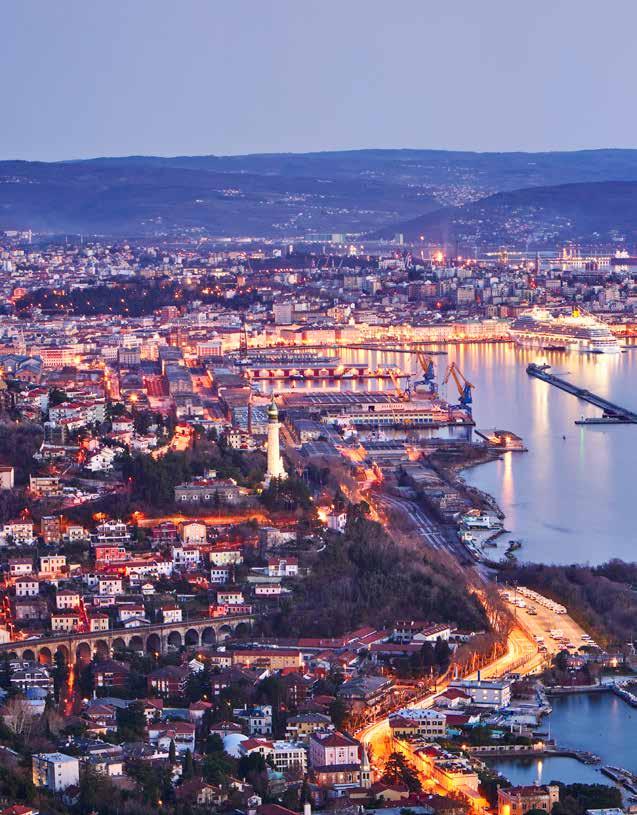
Primavera Green
Bianco, rosso e triestino
Speciale Europei
Under 21: la festa del calcio a Trieste

TRIESTE LIFESTYLE
MARCH 2019
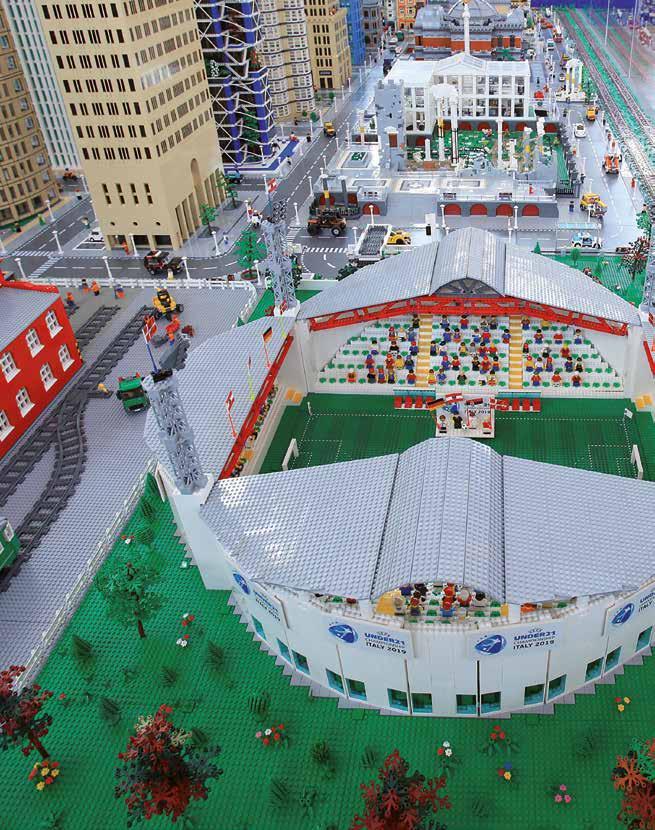




Comune di Trieste @ComunediTrieste ComunediTrieste I Love LEGO Trieste Salone degli Incanti EnjoyTrieste
Trieste (e) il mare Ma quella “e” come la consideriamo? Congiunzione o verbo? Perché, se si tratta di una congiunzione, quello che i turisti sono chiamati a scoprire, ed esplorare, è il “rapporto” della città con il mare. Se invece si tratta di un verbo, da scoprire è la stessa “identità” di una città che si specchia e quasi si identifica con il mare. Rapporto o identità che sia, abbiamo cercato di raccontare Trieste e il suo mare navigando fra storia, storie, architetture, palazzi, luoghi, suggestioni e atmosfere: dai fari ai musei, dai dinosauri ai parchi, dai fasti del porto alla vecchia e nuova Via della Seta, fino a quel calcio che celebra con un Europeo i cento anni di storia rosso alabardata. Alla fine ci siamo convinti che qualunque sia la natura di quella “e”, “congiunzione” o “verbo” che sia, Trieste ha sempre vissuto –e forse sempre vivrà–con il respiro del suo mare.
—
Trieste and the sea Or, rather, Trieste is the sea?
“And” means that visitors are invited to discover and explore the “relation” between the city and its sea. However, if “and” is replaced by “is”, the very identity of Trieste must be searched in the sea, where the city’s reflection glimmers. Be it relation or identity, we looked for Trieste and her sea surfing through history, tales, architecture, palaces, places, suggestions, and atmospheres: from lighthouses to museums, from the splendour of the harbour to the old and new Silk Road, all the way to football and the centenary of The Red Halberded [i.e. Trieste’s football club], culminating with the European Championship. Eventually, regardless of the word that links them, we believe that Trieste and her sea live through each other, one breath and one heartbeat they always have and they always will.
Alfonso Di Leva
Ies Magazine Trieste Lifestyle
N° 5 – March 2019
direttore responsabile
Alfonso Di Leva
supervisione editoriale
Giovanni Marzini
hanno collaborato
Paola De Cassan, Matteo
Contessa, Alice Fabi, Isabella
Franco, Nicolò Giraldi, Francesca Pitacco, Ilaria
Romanzin
traduzioni
Rita Pecorari Novak, Eugenia
Dal Fovo, Rebecca Blakey
progetto grafico
Matteo Bartoli – Basiq
progetto editoriale
Prandi Comunicazione & Marketing
segreteria di redazione
Fabiana Parenzan redazione@prandicom.it
foto di copertina
Roberto Pastrovicchio
fotografie
Nika Furlani, Giovanni Gastel, Fabrizio Giraldi, Giuliano
Koren, Mollusk, Roberto Pastrovicchio, Comune di Trieste – Fototeca dei Civici Musei di Storia ed Arte, Archivio Adobe Stock
stampa
Riccigraf – Trieste
CITTÀ DA SCOPRIRE DISCOVER THE CITY Europei Under 21 2 di Matteo Contessa Mare 10 di Nicolò Giraldi Fari 16 Illustrazioni di Jan Sedmak Oriente 20 di Paola De Cassan Revoltella 26 Muca 28 Dinosauri 31 di Ilaria Romanzin Porto Vecchio 32 di Francesca Pitacco PORTFOLIO Tre secoli di porto 38 Archivio dell’Autorità di Sistema Portuale del Mare Adriatico Orientale CITTÀ DA VIVERE LIVE THE CITY Teatro 48 Top Five Green 52 di Isabella Franco Festival Link 58 Mercati Barbacan Produce 60 Mostre 61 Lego 64 CITTÀ DA GUSTARE TASTE THE CITY Baccalà 66 di Alice Fabi In città The best Jota 70 Food Casa Pepe 72 Pinza e cotto 74 Caffè degli Specchi 76 Fuori Porta 78 Collio Experience
N°
Autorizzazione del Tribunale di Trieste del 16 marzo 2018, numero periodico 9/2018 V.G. 847/2018.
5
TRIESTE LIFESTYLE IES N°5 — March 2019 Sommario
EUROPEI UNDER 21

2 TRIESTE LIFESTYLE IES N°5 — March 2019 Città da scoprire
Dopo il centesimo rossoalabardato, quello del secolo di vita della Triestina, il centounesimo anno di calcio a Trieste sarà quasi un arcobaleno, con i colori di Serbia, Germania, Austria e Danimarca che giocheranno a giugno tre partite del girone B nella fase finale del Campionato Europeo di calcio Under 21. Dieci anni dopo l’ultima volta, lo stadio “Nereo Rocco” ritrova dunque la ribalta internazionale.
Ma un’altra partita altrettanto importante si sta già giocando intorno agli stadi, è quella del turismo. Figc, Regione, i Comuni di Trieste e Udine la giocheranno insieme, puntando sulla qualità e mirando al segmento familiare e giovanile. Fornito di Fvg Card, il passepartout che apre ai turisti le porte su un’infinità di opzioni, chi verrà a vedere le partite potrà fruire del patrimonio culturale dell’intera regione. Tutte le opportunità proposte dalla Regione saranno sul sito web www.turismofvg.it.
Trieste vivrà tutto il mese di giugno proiettata nell’evento. Un percorso pedonale in centro, con totem ad evidenziare luoghi d’interesse o punti di animazione; campi di calcio a 5 in erba sintetica; un ingresso gratuito a tutti i
di / by Matteo Contessa
musei comunali e a tutte le mostre in luoghi cittadini dall’1 al 30 giugno, con visite guidate nelle lingue dei Paesi delle 4 squadre del girone; rassegne cinematografiche e artistiche dedicate al calcio e allo sport. E molto altro è ancora in via di definizione. Ci sarà tutto sui siti www.retecivica.trieste.it, sulla pagina Facebook del Comune di Trieste, sul profilo Twitter @ComunediTrieste e su quello Instagram ComunediTrieste.
“Il valore per Trieste dell’Europeo Under 21 si misurerà sulle eredità che lascerà alla città –spiega Andrea Stefani, il Project Leader Figc dell’Europeo–. Uno stadio migliorato e in grado di ospitare calcio internazionale, il know how per l’organizzazione di grandi eventi come questo, l’ulteriore rilancio turistico del luogo e il lascito valoriale ai giovani, con progetti di cultura sportiva dedicati a loro. Tutto questo resterà a Trieste anche dopo la fine dell’Europeo”.
La terza partita sarà quella dell’avanzamento culturale del calcio. L’incubatrice è una piattaforma web, “Tifiamo Europa”, che coinvolge in questo progetto scuole primarie e secondarie di tutta Italia. Sarà il seme gettato nella terra. Poi, se son rose...
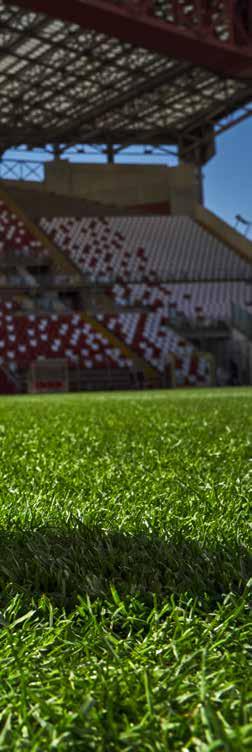
3 TRIESTE LIFESTYLE IES N°5 — March 2019 Discover the city
Trieste e il suo stadio ‘Nereo Rocco’ ritrovano la ribalta internazionale — Trieste’s Stadio Nereo Rocco will host an international tournament again
ENGLISH TEXT

After the centenary of The Red Halberded [i.e. Trieste’s football club], celebrating its hundredth anniversary in 2018, this year brings a rainbow of colours to Trieste’s football landscape, with Serbia, Germany, Austria, and Denmark (Group B) about to face each other in June in the three games of the final round of the UEFA European Under-21 Championship. The three matches will take place in Trieste, at the Stadio Nereo Rocco, ten years after the last time this stadium hosted an international tournament.
Yet, a different, but equally important match is already being played outside the stadium: it is the tourism challenge. The Italian Football Federation [Italian: Federazione Italiana Giuoco Calcio ; FIGC], the Region of Friuli Venezia Giulia, the municipalities of Trieste and Udine are joining their forces to attract families and young people by providing outstanding quality standards. Indeed, football enthusiasts may enjoy both the thrill of the Championship and the charm of the local cultural heritage with one single pass: the Fvg card, a key to countless touristic options within the Region. Further details will soon be available at www.turismofvg.it.
Trieste is dedicating the entire month of June to the Championship and related events: a walking itinerary leading through the city centre, with totem-like poles signalling landmarks or animation points; two
Trieste vivrà tutto il mese di giugno proiettata nell’evento. Un percorso pedonale in centro e rassegne cinematografiche e artistiche dedicate al calcio e allo sport. —
Trieste is dedicating the entire month of June to the Championship and related events: film- and art festivals dedicated to football and sports in general.


five-a-side football pitches covered with synthetic grass in two of Trieste’s main city squares, Piazza Unità and Piazza Sant’Antonio, respectively; free entrance to every municipal museum and all exhibits in the city from 1st to 30th June, with guided tours available in the respective languages of all four nations participating in the tournament; night-time animation and shopping opportunities from 15th to 23rd June within the city centre; filmand art festivals dedicated to football and sports in general. Information and

Lorem amet,consectetuer adipiscing sed nonummynibh euismod laoreetdoloremagna aliquameratvolutpat. enim minim veniam, nostrud exercitationullamcor suscipitlobortis commodoaliquipconsequat. Loremipsumdolor amet,consectetuer adipiscing sed diamnonummynibh euismod incidunt laoreetdoloremagna aliquameratvolutpat. Loremipsum amet,consectetuer adipiscingnonummynibh euismodtincidunt laoreetdolore aliquameratvolutpat. Loremipsumdolor amet,consectetuer adipiscing diamnonummy euismodtincidunt laoreetdoloremagna aliquam volutpat. veniam,quisnostrud ullamcor suscipitlobortis commodoaliquip equat.
Loremipsum amet,consectetuer dipisnonummy euismo tincidunt laoreetdoloremagna aliquam volutpat. minim veniam, nostrud xerci ullamcor mmodouscipitaliquipconsequat. Loremipsumdolor consectetuer nonummy euismod laoreet magna aliquam volutpat. Loremipsumdolor consectet adipisci sed tincidunt laoreetdolorevolutpat. Loremipsumdolor amet,consecte adipiscing sed nonummy euismodtincidunt laoreet magna iqua volutpat. enim stru ullamcor suscipitlobortis commodoaliquipconsequat. Loremipsumdolor amet, adipiscingconsectetuer diamnonummynibh euismodtincidunt laoreetdoloremagna aliquameratvolutpat. minim veniam, nostrud exercitationullamcor suscipitlobortis commodoaliquipconsequat. Lorem psumdolor consectetuer adi cing nonummynibh euismodtincidun oree magna aliquameratvolutpat. Loremipsumdolor amet, adipiscingconsectetuer diamnonummynibh euismodtincidunt laoreetdoloremagna aliquameratvolutpat. Gli allestimenti previsti per festeggiare l’evento di giugno 4 TRIESTE LIFESTYLE IES N°5 — March 2019 Città da scoprire
Il pallone nel piatto
Volete continuare a parlare di calcio a tavola in un saporito dopo-partita? A Trieste è facilissimo perché a poche decine di metri dallo stadio trovate la trattoria “C’era una volta”, gestita da una vecchia gloria della Triestina che prima di cimentarsi in cucina di professione faceva il difensore: si chiama Renato Tugliach, ma oggi è molto più famoso per la specialità del suo accogliente ristorante. Parliamo della carne, cotta in tutti i modi (dalla brace alla padella) ma quel che più conta, decisamente squisita. Da sempre frequentato da sportivi, questo rifugio per gourmet durante gli Europei vi potrà accogliere anche in un grazioso spazio all’aperto, con un menù che non si limita a braciole e filetti ma spazia anche su antipasti e primi, con suggestioni toscane di grande spessore, fra coppe, trofei, ricordi e foto storiche del mondo del calcio. Una cucina che tocca alti livelli, pari almeno a quel pallone che Tugliach scagliò altissimo per salvare la sua porta in una partita di cinquant’anni fa: un leggendario rinvio che mandò la sfera oltre la gradinata del vecchio stadio triestino, facendo cadere il pallone in mezzo al traffico dell’adiacente via Flavia. “C’era una volta” è in piazzale Giarizzole (tel. 040 827346).

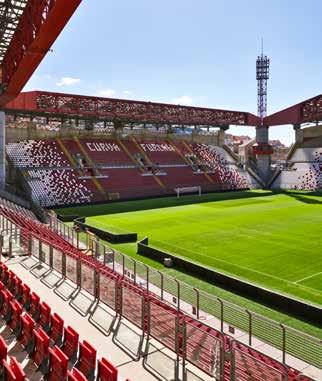
Football on the table
The game is over, but your thirst for football is not. What could be better than a tasty meal flavoured with more football talk? It happens in Trieste, just a short walk away from the stadium, at the trattoria “C’era una volta” [lit. Once upon a time]. The owner and manager is Renato Tugliach, former glorious defender of The Red Halberded, and now famous for the delicious specialties served in his welcoming restaurant. First and foremost meat, cooked and served in every possible way (from grill to pan), which is always, and this is perhaps the most important thing, absolutely excellent. A safe haven for sport enthusiasts of every kind, the trattoria will provide for a gourmet retreat during the European Championship, where guests may relax in a delightful open-air space, choosing from a wide selection of skewers and tenderloins, but also appetizers and first courses, with significant influences from Tuscany –all this while surrounded by trophies, cups, mementos, and memorable pictures of the world of football. High-level cuisine, almost as high as the ball that Tugliach kicked to save his goal fifty years ago: a legendary return that sent the ball over the terraces of the city stadium, where it landed in the midst of the car traffic crowding adjacent Via Flavia. The trattoria “C’era una volta” is located in piazzale Giarizzole (tel. +39 040 827346).
5 TRIESTE LIFESTYLE IES N°5 — March 2019 Discover the city
Football enthusiasts may enjoy both the thrill of the Championship and the charm of the local cultural heritage with one single pass: the Fvg card.
contacts will be made available at www. retecivica.trieste.it, on the Facebook pages of Trieste’s Municipality, on @ ComunediTrieste Twitter profile, and on ComunediTrieste Instagram profile.
“Trieste’s investment in the UEFA European Under-21 Championship will be measured against the legacy it leaves to the city –stated Figc European Championship Project Leader Andrea Stefani– a renovated stadium, able to host international football, the necessary know how for the organisation and management of large-scale events, promotion of the local territory, and a valuable legacy for the youth, to whom countless sport-related cultural projects are dedicated. All this will remain in Trieste long after the Championship is over.”
The third and final ongoing challenge is the enhancement of football culture. The first step is the creation of a web platform name “Tifiamo Europa” [lit. We root for Europe], a project addressed to Italian primary and middle schools. It is but a tiny seed tossed in the earth. Only time will tell how it’ll grow…
È un legame centenario quello che unisce Trieste al calcio e poco importa se la squadra che rappresenta la città manchi dalla massima serie nazionale da 60 anni almeno. Alle maglie rossoalabardate il poeta triestino Umberto Saba dedicò versi indelebili; uno dei figli di questa città, Pino Grezar, giocò nelle fila del grande Torino schiantatosi sulla collina di Superga; altri triestini illustri contribuirono ai successi internazionali delle squadre italiane, una su tutte quel Milan che vide il capitano Cesare Maldini alzare al cielo (primo italiano nella storia del nostro calcio) una Coppa dei Campioni, guidato in panchina da quel Nereo Rocco, nell’indimenticabile sfida di Wembley vinta per 2 a 1 sul Benfica del grande Eusebio. Una figura leggendaria, quella del Paron, soprannome che suona forse burbero, per una persona di spiccata umanità e incredibile simpatia, capace di trasformare una squadra in una grande famiglia, gruppo coeso a tratti invincibile. Come testimoniano gli scudetti e le coppe vinte in una carriera sin troppo breve. Morì quarant’anni fa Nereo Rocco, all’età di 67 anni. Ma a Trieste il suo cappello e quel profilo inconfondibile li potrete ritrovare dentro quello stadio che non poteva che portare il suo nome.
A century –long bond unites Trieste and football– a bond that remains untouched by the fact that the city’s team has not made the top competition league for the last 60 years. The Red Halberded was even celebrated in the unforgettable verses by Trieste’s poet Umberto Saba; Pino Grezar, one of Trieste’s children, was a member of the glorious formation of Grande Torino when the 1949 Superba air disaster took the lives of the entire football team; other talented Triestini also contributed to the international success of numerous Italian football teams, suffice it to mention A.C. Milan, whose captain, Trieste’s own Cesare Maldini, was the first Italian football player to ever lift a European Cup, after the historic match against Eusebio’s Benfica, held at Wembley Stadium, London, on 22 May 1963. Milan won the match 2–1, winning the European Cup under the guidance of manager Nereo Rocco. Nereo Rocco was known as the Paron [Trieste dialect term, lit. the boss], perhaps a too grouchysounding term to refer to a legendary, yet incredibly humane and friendly figure of Italian football, who was able to turn his team into a great family, as well as a close-knit, at times invincible, group of athletes – as witnessed by the numerous cups and championship victories filling this man’s bright, yet too short career. He died forty years ago, when he was just 67 years old. However, his hat and unmistakable profile live on, in the city stadium that inevitably carries his name.

Nereo Rocco
Gli appassionati che verranno a vedere le partite potranno fruire del patrimonio culturale dell’intera regione con la Fvg Card. –
6 TRIESTE LIFESTYLE IES N°5 — March 2019 Città da scoprire
Nereo Rocco




ph F. Gallina
“Strada Vino e Sapori
Friuli Venezia Giulia”

Sei itinerari per scoprire il territorio attraverso i suoi prodotti e produzioni. Da noi in Friuli Venezia Giulia le porte sono aperte per te.
In Friuli Venezia Giulia territorio, vini, prodotti tipici e cucina sono stretti da un legame indissolubile.
La Strada del vino e dei Sapori del FVG unisce cantine, ristoranti e produttori rispettosi dei valori di qualità, genuinità, professionalità ma soprattutto di accoglienza e cordialità per regalarti un’esperienza di vacanza profonda lungo un percorso dei sensi che si snoda dalla costa alla montagna, passando per vigneti e colline.
Scopri chi è aperto oggi:
www.tastefvg.it
Dagli zoppoli del Carso alla
Fincantieri, dalla letteratura ai motti di spirito, il legame di Trieste con il mare parte dal lastricato romano del centro storico e arriva nell’abisso
della Fossa delle Marianne —
From the Karst zoppoli to Fincantieri, from literature to jokes, the connection between Trieste and her sea starts from the ancient Roman cobbled road in the city centre and leads to the abyss of the Mariana Trench
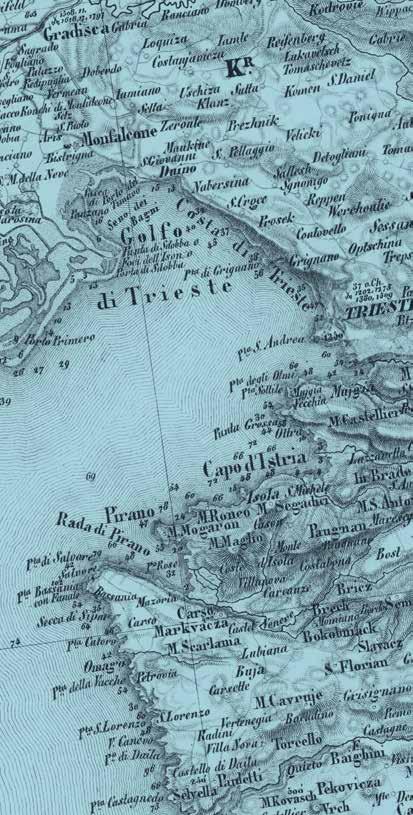
MARE
di / by
10 TRIESTE LIFESTYLE IES N°5 — March 2019 Città da scoprire
Nicolò Giraldi
Èil 4 novembre 1918. Sul fronte mare di Trieste si è radunata una folla di migliaia di persone che, dopo la notizia della fine della guerra e l’arrivo dei Bersaglieri, è scesa in strada per vivere uno dei momenti chiave della storia novecentesca di queste terre. Tra i triestini c’è anche Antonio Zetto, ventenne, nato a Isola d’Istria. Passeggia sulle rive e respira la gioiosa atmosfera. A pochi metri ci sono alcune imbarcazioni che trasportano prigionieri di guerra.
Qualcuno dalla nave diretta a Venezia lo chiama, lo invita a salire a bordo. “Toni”, dopo l’incertezza iniziale, decide di mettere piede su quella nave che, simbolicamente, lo porterà a viaggiare su tutti i mari del pianeta per 14 anni.
“L’uomo che dimenticò di diventare milionario” (questo il titolo del libro che Ugo Sartori nel 1933 scriverà per narrare le sue vicende) diventa così il simbolo del legame fra Trieste e il mare, in particolare l’andar per mare. Navigare.
La storia triestina con l’Adriatico, ma anche con tutti i mari del mondo, ha una radice che nasce sulla superficie del la stricato romano del centro storico e termina nella Fossa delle Marianne, il punto più profondo degli oceani. E guar da caso, quell’abisso venne esplorato per la prima volta, il 23 gennaio 1960, da un batiscafo che portava il nome della cit tà giuliana.

Navigare per Trieste non è stato quasi mai un problema. Fin dai tempi antichi flotte romane sono giunte nello specchio d’acqua più a nord del Mediterraneo.
La tradizione marinara si fonda con l’estetica umana alla base del cordone
ombelicale che lega l’urbe alle tonalità blu e azzurre, in quel colore che viene definito non a caso, blu oltremare.
Ogni civiltà che si rispetti ha navigato lungo i corsi d’acqua grazie a monossili, vale a dire grandi tronchi d’albero trasformati in imbarcazioni. Le genti dell’abitato di Santa Croce invece inventano le čupe, in italiano “zoppoli”; erano “barche” che venivano forgiate sul Carso e poi trasportate in riva al mare e che servivano agli abitanti del paese per pescare.
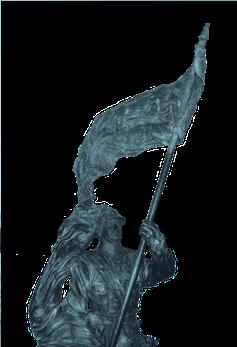
La frazione di Canovella degli zoppoli prende il nome proprio da questa tradizione. L’ultima costruzione di una čupa risale al 1998. Dopo il varo venne fatta navigare fino davanti a piazza Unità, nel trentesimo anniversario della Barcolana.
Storia diversa e dimensioni diverse sono quelle dei cantieri navali, da quelli artigianali che da sempre costellano la periferia a ridosso del mare per la manutenzione e le piccole riparazioni, fino al colosso globale che, dai Cantieri Navali Triestini, è arrivato a far sventolare la
Monumento ai bersaglieri 11 TRIESTE LIFESTYLE IES N°5 — March 2019 Discover the city
bandiera della Fincantieri, che qua ha da sempre la sua testa, il suo cuore e i suoi centri nevralgici, sulle navi da crociera più belle e grandi del mondo.
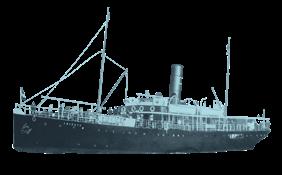
A cavallo tra l’Ottocento e il secolo successivo le imbarcazioni che solcano il mare di Trieste dipingono le rive di colori sgargianti e di ciminiere fumanti. Trabaccoli, pièleghi, tartane, brazzere e vaporetti navigano lungo rotte vicine, sognando epopee dal fascino esotico. Proprio due vaporetti, nel 1911, diventano protagonisti di un duello sul mare. Partono uno a fianco all’altro dalle rive triestine in direzione Capodistria. Nazario Sauro comanda il “San Giusto” mentre al timone del “Lampo” c’è il capitano Ferrari. Tentano di superarsi a vicenda, fino a quando Sauro investe il Lampo, al quale aveva probabilmente tagliato la strada. La vicenda si conclude con l’arresto di Nazario Sauro, colpevole di ingiurie nei confronti dell’altro capitano.
È infatti la lingua il luogo dove l’amore per il mare dei triestini sfocia nel singolare registro espressivo del dialetto. Canzoni e modi di dire, prese in giro e metafore, tutte ondeggiano nella quotidianità grazie al mare. “Le mule de San Giacomo le porta el Cristo in petto, le ga el marì che naviga e l’amante sotto el letto”, dipinge il tradimento delle donne sole, in attesa dei propri naviganti.
“Anversa, traversada persa” ricorda i marittimi triestini che, sbarcati nelle Fiandre di ritorno dalle Americhe, tendevano a scialacquare i soldi guadagnati nelle trattorie e nei bordelli della città dei diamanti. “Do’ te navighi?” ridisegna l’interlocutoria presa in giro nei confronti dei “naufraghi” di terra.

Il cantiere San Marco divenne per decenni il simbolo delle imbarcazioni che qui venivano costruite, per finire a solcare i sette mari. Ma benché si ideassero scafi metallici, è Trieste il luogo dove fino a non poco tempo fa viveva uno degli ultimi mastri d’ascia di tutto l’Adriatico: il suo nome era Nicolò Giraldi e fin da piccolo in Istria imparò il mestiere, fatto di calafataggio e legno d’opera, volto a realizzare barche ormai entrate nel mito.
Navigare, per Trieste, possiede molti significati: ci sono vele di cotone, uomini bruciati dal sole, visioni sottomarine, sbuffi di sale e, ancora, partenze senza ritorno, istmi tagliati e réclame di compagnie di navigazione triestine su gazzette ad Hong Kong, Tokyo o Buenos Aires. “Navigare necesse est, vivere non necesse” scrisse Plutarco: per le generazioni di triestini che dopo aver concluso gli studi all’Istituto Nautico hanno scelto e continuano a scegliere la via del mare, probabilmente, è stato e sarà sempre così.
La
—
There is an entire language register of Trieste’s dialect dedicated to the sea and Triestini’s love for it. Lyrics and idioms, jests and metaphors: they all find their ways to everyday life thanks to the sea.
ENGLISH TEXT
It is the 4th of November, 1918. Trieste’s waterfront is impossibly crowded: when news arrived that the war had ended and when the Bersaglieri [lit. Marksmen, specialty of the infantry corps of the Italian Army] entered the city, thousands of people gathered here to live one of the key moments of the 20th century and this territory’s history. Among them Antonio Zetto, twenty years old, born in Izola, Istria. He is pacing the rive and breathing in the joyful
Piroscafo Trieste
lingua è il luogo dove l’amore per il mare dei triestini sfocia nel singolare registro espressivo del dialetto. Canzoni e modi di dire, prese in giro e metafore, tutte ondeggiano nella quotidianità grazie al mare.
12 TRIESTE LIFESTYLE IES N°5 — March 2019 Città da scoprire
atmosphere. Nearby, approaching the docks, there are ships carrying war prisoners. Someone from the ship sailing for Venice calls him, inviting him to jump on board. And so it is that “Toni”, after a moment of hesitation, decides to accept the invitation, which initiates a 14-year-long journey that will take him across all the seas of the planet.
“L’uomo che dimenticò di diventare milionario” [lit. The man who forgot to become a millionaire]: this is the title of the book Ugo Sartori wrote in 1933 to tell Antonio Zetto’s story. The man who forgot to become a millionaire truly became a symbol of Trieste’s connection to her sea, especially through seafaring. Sailing.
The history of Trieste and the Adriatic Sea, and, by extension, every sea in the world, starts from the uneven surface of the ancient Roman cobbled


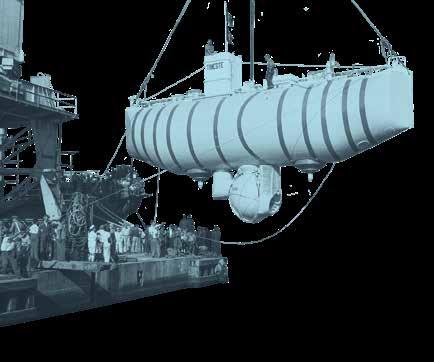
road in the city centre and leads to the depths of the Mariana Trench, the deepest natural underwater trench in the world. Coincidentally, the first exploration of the Mariana Trench took place on 23rd January 1960, a manned descent by Swiss-designed, Italian-built, United States Navy-owned bathyscaphe named Trieste. Sailing was almost always part of Trieste’s very soul. Ancient Roman fleets first reached this northern-most point of the Mediterranean by sea. This marine tradition is reflected in human aesthetics, linking the city to the various tones of blue and azure, merging in the unique pigment (incidentally) called ultramarine.
One way or another, every civilization has sailed the waterways on various kinds of monoxyla, or dugout, namely boats made from hollowed tree trunks. The inhabitants of Santa Croce are no exception: they invented the čupa, also known as zoppolo, a boat carved out of tree trunks on the Karst Plateau and then carried all the way to the seaside, where villagers set out to sea to fish.
Canovella degli zoppoli was indeed
named after these traditional boats. The last čupa was built in 1998: after its launch it was sailed all the way to the waterfront of Piazza Unità for the celebration of the Barcolana’s 30th anniversary.
Different story and different size: Trieste’s shipyards range from tiny to colossal. The smaller ones are scattered along the coast just outside the city centre and offer mainly maintenance and minor reparation services. The real colossus is Fincantieri, formerly Cantieri Navali Triestini [lit. Trieste Shipyards], whose heart, head, and nervous centre reside in Trieste, and whose flag flies on the greatest and most beautiful cruise ships in the world.
TS Batiscafo Trieste
M13 TRIESTE LIFESTYLE IES N°5 — March 2019 Discover the city
Nazario Sauro
Between the 18th and the 19th century, the sea of Trieste was cut through by watercrafts painting the coast with their bright colours and smoking chimneys. Trabaccoli [Adriatic Sea sailing coasters], pièleghi (smaller trabaccoli], tartans, brazzere [similar to bragozzi], and steamboats used to sail along coastal routes, dreaming of epic deeds in exotic lands. In 1911 a full-fledged duel was staged on water by no less than two steamers: headed to Koper, they leave the docks side by side; Nazario Sauro steers the “San Giusto”, while the helmsman of the “Lampo” [lit. Lightning] is captain Ferrari.
They both try to overtake each other, until Sauro’s boat hits the Lampo, probably by cutting in front of her. Nazario Sauro was arrested for verbally abusing his rival.
There is an entire language register of Trieste’s dialect dedicated to the sea and Triestini’s love for it. Lyrics and idioms, jests and metaphors: they all find their ways to everyday life thanks to the sea. “Le mule de San Giacomo le porta el Cristo in petto, le ga el marì che naviga e l’amante sotto el letto” [lit. San Giacomo’s women have a crucifix on their chest, a husband at sea, and a lover under their bed], say the locals about lonely sailors’ wives, waiting for their husbands to come home. The old say “Anversa, traversada persa” [lit. Antwerp, a wasted crossing] refers to Trieste’s sailors, who stopped in Flanders on their way back from the Americas, and spent all their hard-earned money in the inns and brothels of the city of diamonds. “Do’ te navighi?” [lit. Where are
you sailing to?] was a jest addressed to the city “castaways” on land.
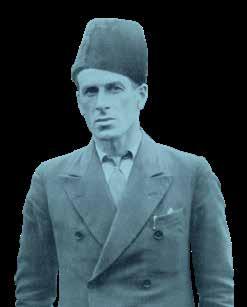
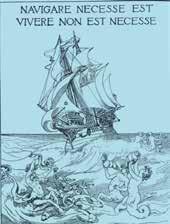
For decades, San Marco shipyard remained the symbol of watercrafts that were built here and then sailed the seven seas. They had metal hulls, and yet, not so long ago, Trieste was home to one of the last caulk masters of the Adriatic Sea: his name was Nicolò Giraldi and he learned this craft in Istria when he was only a child, caulking and working wood to create watercrafts destined to become a myth.
Sailing has various meanings in Trieste: cotton sails, sunburnt faces, underwater images, salty puffs, but also departures without return, isthmuses without connection, and advertisements of Trieste’s sailing companies on foreign dailies, from Hong Kong, to Tokyo, to Buenos Aires. “Navigare necesse est, vivere non necesse” [lit. Sailing is necessary, living is not] Plutarch wrote –and young generations of Triestini graduating from the renowned Istituto Nautico di Trieste [Trieste Naval Academy], who keep choosing a life at sea, bear testimony to his intuition– they always have and always will.
Antonio Zetto, “L’uomo che dimenticò di diventare milionario”, è il simbolo del legame fra Trieste e il mare, dell’andar per mare. —
Antonio Zetto, the man who forgot to become a millionaire is a symbol of Trieste’s connection to her sea, especially through seafaring.
14 TRIESTE LIFESTYLE IES N°5 — March 2019 Città da scoprire
Antonio Zetto
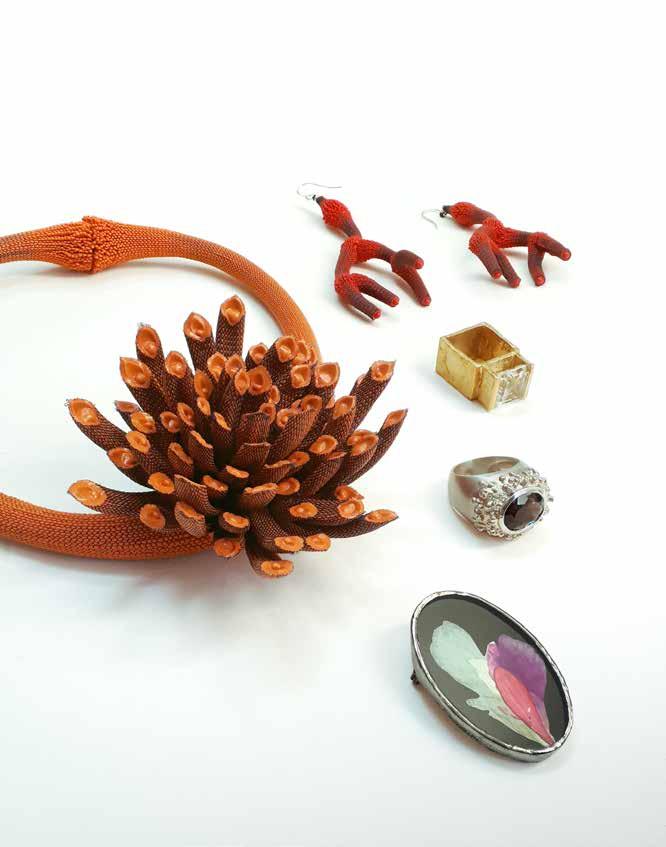
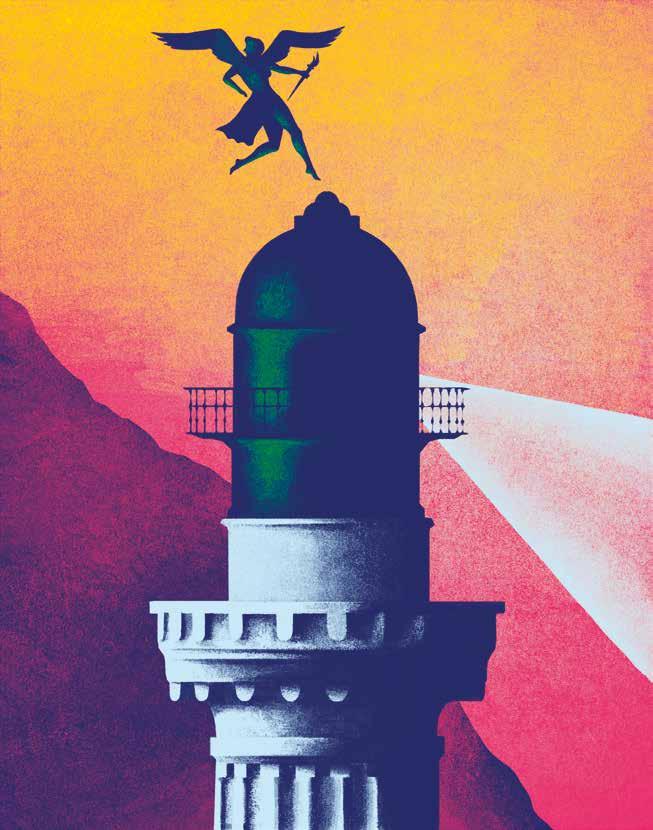
16 TRIESTE LIFESTYLE IES N°5 — March 2019 Città da scoprire
Illustrazioni di / Illustrations by Jan Sedmak Per le città sono un simbolo; per gli uomini, di terra e di mare, hanno un fascino eterno: vederli lampeggiare significa che il porto è oramai vicino.
For every city they are a symbol; people, on land and at sea, are still fascinated by their charm: when their light blinks it means that harbour is close.
Per gli uomini di mare sono da sempre una certezza: vederli lampeggiare significa che il porto è oramai vicino. Basta seguire la luce di questa sentinella silenziosa per ritornare a casa.
Per le città sono un simbolo e, se per la navigazione hanno forse perso parte del loro ruolo, sicuramente, per gli uomini, di terra e di mare, non hanno perso neanche un po’ del loro fascino. A Trieste, città legata indissolubilmente al suo mare, di fari ce ne sono ben due.
Il più antico è l’ex Faro Lanterna; alto 35 metri con una portata di una quindicina di miglia marine, si trova in cima al Molo Fratelli Bandiera. Realizzato su progetto di Matteo Pertsch, entrò in funzione nel 1833. Dovendo fungere pure da difesa del porto, fu realizzato un basamento in pietra a base cilindrica che si erge da una Torre Massimiliana merlata. Con la costruzione del faro della Vittoria, smise di avere importanza e venne disattivato nel 1969. Oggi la Lanterna ospita la sede triestina della Lega Navale e la visita è consentita da lunedì a venerdì 8.30–12.30/15.30–19.30 e sabato 8.30–12.30.
Il Faro della Vittoria, alto 70 metri, con una portata media di 30 miglia, è il faro che ancora oggi indica ai marinai la via di casa. Rivestito all’esterno da blocchi di pietra del Carso e dell’Istria, sovrastato da una cupola che ospita la lanterna, si erge sul colle di Gretta, a 60 metri sul livello del mare.

Inaugurato nel 1927, su progetto dell’architetto Arduino Berlam, è anche monumento commemorativo dedicato ai marinai caduti durante la Prima Guerra Mondiale.
Sull’apice della cupola s’innalza la statua in rame della Vittoria Alata (opera dello scultore Giovanni Mayer) e sotto il faro si trova l’ancora del cacciatorpediniere Audace, la prima nave italiana che attraccò al porto di Trieste nel 1918.
Il Faro della Vittoria è anche uno dei punti panoramici più sorprendenti del golfo di Trieste, sia durante l’anno, sia in occasione della regata velica più affollata del Mediterraneo, la seconda domenica di ottobre, la Barcolana. Info orari www.farodellavittoria.it [PDC]
—
17 TRIESTE LIFESTYLE IES N°5 — March 2019 Discover the city
FARI
For every seafarer they are a certainty: when their light blinks it means that harbour is close. One only needs to follow the light of these silent watchmen to find the way home. For every city they are a symbol: their significance may be diminished in the era of technology, yet people, on land and at sea, are still fascinated by their charm. The lighthouses of Trieste, a city inextricably bound to her sea, are not one but two.
The oldest one is the former lighthouse Lanterna [lit. lantern, beacon]: 35 m high, with luminosity up to 15 nautical miles, this lighthouse was built at the edge of the dock named Fratelli Bandiera . It was designed by Matteo Pertsch and was first activated in 1833. Since it also had a defensive purpose, it was equipped with a cylinder-shaped stone plinth, supporting a castellated casemate. When the second lighthouse, Faro della Vittoria [lit. lighthouse of victory] was built, the Lanterna lost significance and was eventually deactivated in 1969. Today, the lighthouse building hosts the local section of the Lega Navale Italiana (i.e. Italian Naval League) and visitors can access it Monday to Friday (8.30–12.30 a.m. / 3.30–7.30 p.m.) and Saturdays (8.30–12.30 a.m.).
The Faro della Vittoria, 70 m high, with luminosity up to 30 nautical miles, is now the lighthouse pointing seafarers to the way home. Its exterior is coated in stones brought from the Karst Plateau and Istria, all the way up to its summit, where the domed lantern overlooks the
la via di casa.
The lighthouses of Trieste, a city inextricably bound to her sea, are not one but two. The oldest one is the former lighthouse Lanterna; the second one, Faro della Vittoria, 70 m high, is now pointing seafarers to the way home.
city from the hill of Gretta, 60 m above the sea level. It was designed by architect Arduino Berlam and inaugurated in 1927, both as lighthouse and monument memorialising sailors who died in the First World War.
The lighthouse is topped by the copper statue of the Winged Victory (a work by sculptor Giovanni Mayer), while at its foot lies the anchor of destroyer “Audace”, the very first Italian watercraft to dock in Trieste’s port in 1918.
The Faro della Vittoria also offers one of the best panoramic viewpoints over the gulf of Trieste throughout the whole year, but most importantly on the second Sunday of October when the Barcolana takes place, the most popular regatta of the Mediterranean Sea. Information and opening times available at www.farodellavittoria.it
ENGLISH TEXT
A Trieste, città legata indissolubilmente al suo mare, di fari ce ne sono ben due. Il più antico è l’ex Faro Lanterna; l’altro è il faro della Vittoria. Con i suoi 70 metri, ancora oggi, indica ai marinai
18 TRIESTE LIFESTYLE IES N°5 — March 2019 Città da scoprire

19 TRIESTE LIFESTYLE IES N°5 — March 2019 Discover the city
ORIENTE
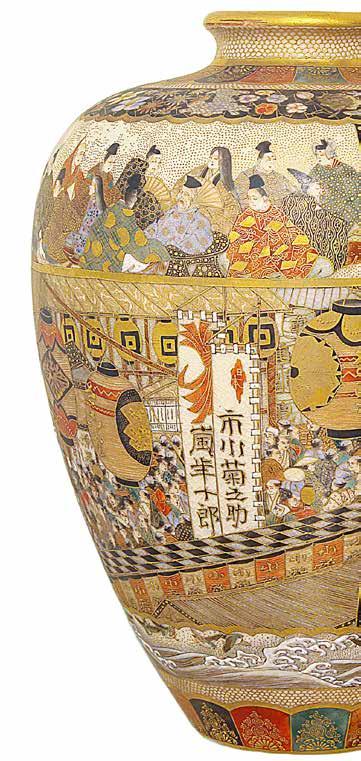
di /by
20 TRIESTE LIFESTYLE IES N°5 — March 2019 Città da scoprire
Paola
De Cassan
Dalla Via della Seta al Museo Orientale — From the Silk Road to the Orient Museum

In via San Sebastiano, in una delle stradine d’accesso alla Città Vecchia, nel cuore di Trieste, s’incontra l’Oriente. Nel Palazzetto Leo, storico edificio del XVIII secolo, già proprietà della famiglia triestina dei Leo e donato nel 1954 al Comune di Trieste, si trova il Civico Museo d’Arte Orientale, il primo a Trieste, fra i primi cinque d’Italia, dedicato a questo mondo.
Un piccolo grande museo, inaugurato l’8 marzo 2001, che raccoglie oggetti d’arte, di artigianato, grafiche e reperti archeologici arrivati dall’Estremo Oriente a Trieste, lungo una mai dimenticata Via della Seta, oggi alla vigilia di un nuovo vigore, che per secoli ha solcato il mare, ma non solo. Quel mare che dalla nascita del Porto Franco
nel 1719, con gli splendori dell’Ottocento e con l’apertura del Canale di Suez nel 1869, ha consentito non solo di trasportare merci e persone, ma soprattutto di collegare culture.
Le navi del Lloyd Austriaco partivano da Trieste e, superato il Canale di Suez, raggiungevano le lontane coste dell’India, della Cina e del Giappone.
E non a caso il Canale di Suez fu fortemente sostenuto e voluto proprio da un uomo che a Trieste aveva radici e storia: il barone Revoltella, nominato perfino vicepresidente della Compagnia universale del Canale di Suez e di cui oggi possiamo ammirare la residenza nel museo che porta il suo nome e che è una straordinaria Galleria d’Arte Moderna.
21 TRIESTE LIFESTYLE IES N°5 — March 2019 Discover the city
Quattro piani di esposizioni da raggiungere attraverso le scale da fare con il naso all’insù per ammirare gli splendidi aquiloni giapponesi del XIX secolo.
The museum’s display is organised on four floors, connected by staircases that are decorated with beautiful 19th-century Japanese kites.

È grazie a questi viaggi e al mecenatismo delle grandi famiglie nobiliari triestine di un tempo (Caccia, Currò, Morpurgo, Barzilai, Artelli, Carlo Zanella, Mario Morpurgo de Nilma, Segrè e Sartorio) che possiamo ammirare a Trieste le bellissime collezioni di abiti e tessuti in seta ricamata del tardo periodo Qing (XIX secolo), porcellane dal periodo Song (XI-XIII secolo) al tardo periodo Qing (XIX secolo), sculture e oggetti legati al Confucianesimo, Taoismo e Buddismo della Cina, oppure le porcellane e le maschere del teatro popolare kabuki o le armi e le armature giapponesi dal XV al XIX secolo, tra cui una lama semplicemente straordinaria, datata 1481.
Unica nel suo genere la collezione di stampe dell’Ukiyo-e, dipinti, lacche, specchi, netsuke e altri oggetti, assegnabili soprattutto all’età Edo o Tokugawa (1603-1868) con opere di grandi maestri dell’arte giapponese tra cui Hiroshige e Hokusai con la celeberrima Onda, che tanta influenza hanno avuto nella grafica occidentale.
Quattro piani di esposizioni da raggiungere attraverso le scale da fare con il naso all’insù per ammirare gli splendidi aquiloni giapponesi del XIX secolo dipinti ad acqua su carta, connessi alla sezione dedicata al Giappone. La loro collocazione rammenta la funzione aerea, levitante, degli aquiloni che nella tradizione giapponese sembrano ondeggiare tra la dimensione secolare mondana e quella spirituale o cerimoniale oltre
a essere simbolo di divertimento per i bambini.
Immancabile la sezione dedicata alla Via della Seta. Secondo la tradizione fu Lei Zu, moglie del mitico Imperatore Giallo, a introdurre l’allevamento del baco in Cina attorno al 2500 a.C.. La produzione della sete crebbe poi rapidamente e durante i secoli di regno della dinastia Han (206 a.C.-220 d.C.) la fama della splendida seta ricamata raggiunse Roma diventando un mezzo di scambio.
Da quel tessuto così prezioso e ricercato, la strada carovaniera che collegava l’Oriente all’Occidente prese il nome. La Via della Seta è la più antica e storica via commerciale del mondo. Durante la Dinastia Han (206 a.C. – 220 d.C.), fino alla Dinastia Yuan (1271-1368 d.C.), ha avuto un’importanza cruciale per l’economia dell’Impero cinese, collegando via terra Europa e Asia.
E ancora oggi il suo nome evoca leggende, affascina i viaggiatori ed evoca suggestioni. Al punto che prende il nome di “Nuova Via della Seta”, la Belt and Road Initiative, il grande progetto della Cina del XXI secolo che punta a rilanciare i collegamenti infrastrutturali e commerciali d’Oriente verso l’Occidente e l’Europa. E ora, come allora, Trieste e il suo porto sono candidati a essere fra gli approdi più importanti della “Via della Seta”.
Il museo d’arte Orientale è visitabile, gratuitamente, da giovedì a domenica dalle 10 alle 17.
—
22 TRIESTE LIFESTYLE IES N°5 — March 2019 Città da scoprire
ENGLISH TEXT
In Via San Sebastiano, one of the tiny streets leading to the Old Town, in the very heart of Trieste, there is a gate to the East: it is enshrined in the 18th-century historic building named Palazzetto Leo, formerly owned by the local family of the same name and subsequently donated to the city of Trieste in 1954. It is the Civico Museo d’Arte Orientale [lit. Civic Museum of Oriental Art], first of its kind in Trieste, and ranking fifth of its category in Italy.
A little big museum, inaugurated on 8th March 2001, with an impressive collection of works of art, handcrafts, graphics, and archaeological artefacts which reached Trieste from the Far East along the unforgotten Silk Road –a road that is gaining new momentum today, not only thanks to the sea routes that have connected East and West for centuries.
Those same sea routes that, since 1719, with the inauguration of Trieste’s Porto Franco [lit. Free-trade Port], and later during the 19th century, with the opening of the Suez Canal in 1869, led to the exchange of goods, encounters between people(s), but, most importantly, connection of cultures.
The Österreichischer Lloyd’s ships would leave from Trieste, and, after crossing the Suez Canal, they would reach the Far East coasts of India, China, and Japan.

It is not surprising, therefore, that one of the greatest supporters of the Suez Canal was a man who had his roots and background in Trieste: baron Revoltella, who even served as vice president of the Suez Canal Company, and whose Trieste residency can still be admired today, in the museum of the same name currently hosting an extraordinary collection of Modern Art.
Those crossings, and the patronage of Trieste’s élite of noble families (Caccia, Currò, Morpurgo, Barzilai, Artelli, Carlo Zanella, Mario Morpurgo de Nilma, Segrè, and Sartorio), made it possible for visitors today to enjoy the sight of fascinating collections of clothes and fabrics embroidered in silk dating back to the late Qing era (19th century), china from the time comprised between the Song (11th-13th century) and the Qing era (19th century), sculptures and artifacts representing diverse cultural heritage, such as Confucianism, Chinese Buddhism, and Taoism, and even china and masks from the kabuki popular theatre, century-old Japanese weapons and armours (15th to
Le navi del Lloyd
Austriaco partivano da Trieste e, superato il Canale di Suez, raggiungevano le lontane coste dell’India, della Cina e del Giappone.
—
The Österreichischer Lloyd’s ships would leave from Trieste, and, after crossing the Suez Canal, they would reach the Far East coasts of India, China, and Japan.
23 TRIESTE LIFESTYLE IES N°5 — March 2019 Discover the city
19th century), including an extraordinary blade dating back to 1481. There is also an absolutely unique collection of Ukiyo-e prints, paintings, varnish, mirrors, netsuke, and other artefacts, especially from the Edo and Tokugawa eras (1603–1868), including artworks of great Japanese masters such as Hiroshige and Hokusai, whose The Great Wave had an unparalleled influence on western graphic art.
The museum’s display is organised on four floors, connected by staircases that are decorated with beautiful 19th-century Japanese water-coloured kites, leading to the Japanese section.
Their position is a constant reminder of their flying function, and, more generally, their meaning in the Japanese tradition, which seems to fluctuate between secular and spiritual dimension, present and ritual, as well as children’s playfulness.
There is also the almost mandatory section dedicated to the Silk Road. According to tradition, it was Lei Zu, wife to the legendary Yellow Emperor, who introduced silkworm breeding to China around the year 2500 b.C. Silk production grew exponentially in the
following decades, until, during the Han dynasty (206 b.C. – 220 A.D.), rumours of Chinese embroidered silk reached Rome, thus becoming both a commodity and a bargaining chip.
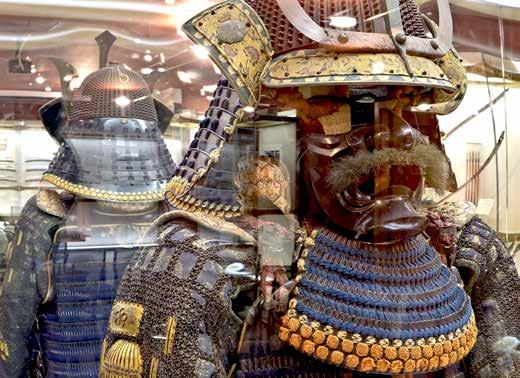
That precious and rare fabric gave its name to the network of trade routes connecting East and West: the Silk Road, the most ancient and significant trade route in the world. During the Han dynasty (206 b.C. – 220 A.D.), and until the Yuan dynasty (1271–1368 A.D.), the Silk Road was a crucial asset of the Chinese Empire economy, providing for the one and only land connection between Asia and Europe.
Today its name still evokes legends and epic deeds, stirring the imagination of every traveller. The “new” Silk Road, namely the Belt and Road Initiative, capitalises on the glory of the past to give new momentum to infrastructures and trade exchanges between East and West in 21st-century China. And Trieste today, like it was in the past, is still a crucial landing point within the Silk Road of the third millennium.
You can visit the Orient Museum free of charge, Thursdays to Sundays, from 10 a.m. to 5 p.m.
Arte, cultura, lacche, armature, stampe, tessuti, aquiloni e porcellane.
—
24 TRIESTE LIFESTYLE IES N°5 — March 2019 Città da scoprire
Art, culture, varnish, prints, fabrics, kites, and china.
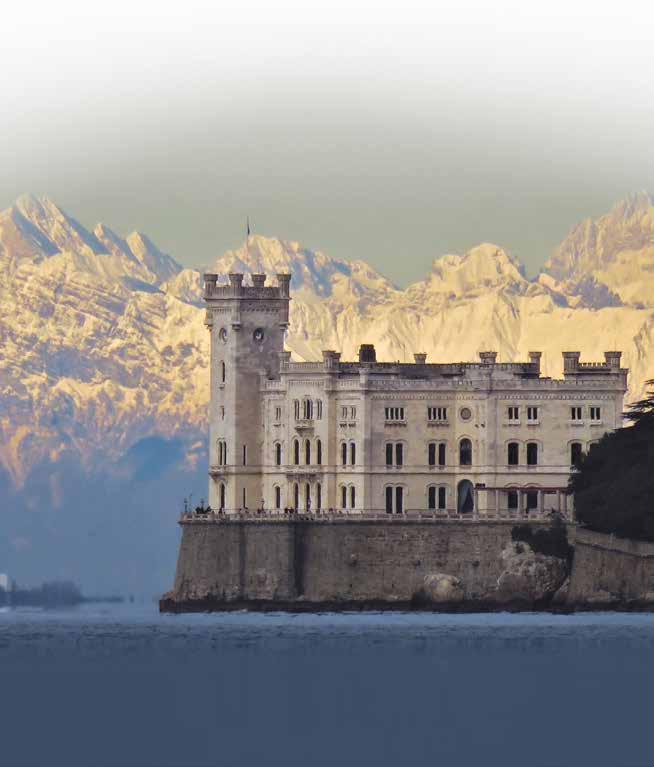

www.aldolceeremo.com Il Bed & Kitchen Al Dolce Eremo è la scelta di chi cerca un soggiorno rilassante, ma allo stesso tempo stimolante, in una location raffinata ed accogliente. Via dell’Eremo 46 - 34142 Trieste - Italy T. +39 335 5292548 - aldolceeremo@gmail.com Struttura convenzionata con
REVOLTELLA
Un amore segreto per la sua città d’adozione, che lo portò a donarle le immense ricchezze, i palazzi, le opere d’arte accumulate in anni e anni di lavoro, affari, intuizioni e mecenatismo.
Ci sono due luoghi che testimoniano l’amore infinito che Pasquale Revoltella nutrì per Trieste e che, a 150 anni dalla morte di questo self made man ante litteram, sono ancora un vanto della città: lo splendido Museo, che porta il suo nome, e la Villa, appena in periferia, nella quale amava rifugiarsi per riscoprire il suo rapporto con la natura, ancora oggi custode di alberi unici e affascinanti.
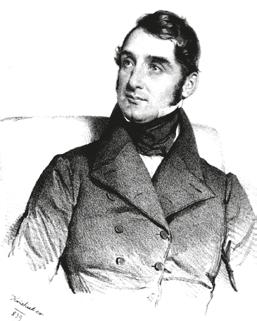
Ci sono due luoghi che testimoniano l’amore infinito che Pasquale Revoltella nutrì per Trieste: lo splendido Museo e la villa. —
There are two places where Pasquale Revoltella’s undying love for Trieste is particularly evident: the magnificent museum and Revoltella’s Villa.
Il Museo Revoltella, invece, nel cuore della Città Vecchia, con la dimora storica di questo veneziano trasferitosi fin da bambino a Trieste, è un imponente e prezioso contenitore di centinaia di opere d’arte che il barone, nato a Venezia nel 1795 e morto a Trieste 74 anni dopo, acquistò con i proventi dei suoi affari, sempre legati al mare e alle navi, ai commerci e alla finanza, come l’iniziale compravendita di legnami e granaglie, o le successive partecipazioni in colossi del calibro di Assicurazioni Generali e Lloyd Austriaco, che contribuì a fondare, o la costruzione del canale di Suez, di cui divenne vicepresidente. Stoffe, arredi, marmi, la maestosa scalinata con tanto di fontana, le stanze private e le sale di rappresentanza, la grande sala da pranzo perfettamente conservata, oggi tutto nel magnifico palazzo del Barone Revoltella porta indietro nel tempo, alle ovattate atmosfere della Bella Epoque e all’incredibile personalità di questo commerciante dal cuore d’oro e dalle strane abitudini. Come quella di guardare chi passava per strada stando comodamente seduto su un divanetto, in uno dei suoi salottini. La camera ottica che glielo consentiva è ancora lì, intatta, proprio come quasi due secoli fa.
26 TRIESTE LIFESTYLE IES N°5 — March 2019 Città da scoprire
His secret love for the city that adopted him led him to bequeath Trieste enormous treasures, palaces, and works of art collected through an entire life of work, business, intuition, and patronage.

There are two places where Pasquale Revoltella’s undying love for Trieste is particularly evident – places that remain two of Trieste’s flagships today, 150 years since the passing of a self-made man ahead of his own time: a magnificent Museum carrying his name, and Revoltella’s Villa, just outside the city, where he used to retreat and devote time to nature, as witnessed today by the unique and beautiful trees of the luxurious park surrounding the villa.
The Revoltella Museum, in the very heart of the old town, where Revoltella’s family moved to when he was just a child, is an imposing treasure chest of hundreds of works of art that the Baron,
born in Venice in 1795 and living in Trieste until his passing in 1869, purchased with the revenue from his shipand sea-sailing business, his financial investments –notably timber and grain–and his subsequent shares in business titans, such as Generali insurance company and Österreichischer Lloyd shipping company, which he contributed to found, or even in the Suez Canal construction, of which he became vice president.
Fabrics, furniture, marble, the grandiose staircase and its fountain, the private quarters and ceremonial rooms, the great and perfectly preserved dining room – everything in Baron Revoltella’s magnificent palace takes visitors back in time, to the cocoon-like atmosphere of the Belle Époque, where this peculiar tradesman and his heart of gold inspired the city and its citizens. Those he used to watch languidly lying on a sofa in one of his parlours. The optic chamber built precisely for this purpose is still there, its look of two centuries ago still intact.
ENGLISH TEXT
27 TRIESTE LIFESTYLE IES N°5 — March 2019 Discover the city
Il Palazzo del Barone Revoltella, in Piazza Venezia.
MUCA
Icantieri navali più grandi d’Italia racchiusi in un museo e un museo che si trasforma in un cantiere per far vivere storia, rumori, immagini e sensazioni che per decenni hanno reso e rendono viva e unica la città-fabbrica di Monfalcone, alle porte di Trieste. È il MuCa, il Museo della Cantieristica, uno straordinario allestimento che ricostruisce la Linea del Tempo dedicata alle vicende dei cantieri di Panzano e del suo territorio. Il museo catapulta il visitatore tra i rumori del cantiere; gli consente di giocare con il simulatore di gru; ascoltare le voci dei sei grandi protagonisti della storia dei cantieri, da Callisto Cosulich a Dante Fornasir, da Egone Misso a Niccolò Costanzi, da Tranquillo Marangoni a Elda.
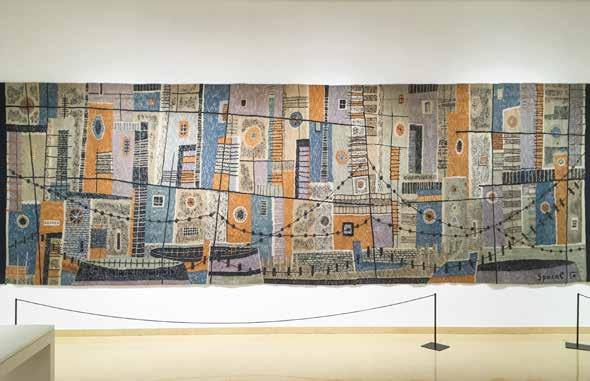
E di ammirare i grandi modelli delle navi da crociera e le opere di grandi artisti come Zoran Mušič, Vito Timmel, Marcello Mascherini che decoravano gli interni delle navi, fino a commuoversi davanti al Memoriale delle vittime per l’amianto.
Il Museo è stato realizzato nell’ex Albergo Operai del Villaggio di Panzano, in un edificio progettato negli anni Venti dall’ingegnere Fornasir, di stile secessionista – la struttura ricorda l’Hotel Métropole di Vienna – nato per ospitare gli operai celibi del cantiere.
L’albergo occupava quasi 5.000 metri quadrati, aveva 700 stanze piccole come celle ma con il riscaldamento, 1.300 finestre e interminabili corridoi che incutevano timore tanto da
28 TRIESTE LIFESTYLE IES N°5 — March 2019 Città da scoprire
soprannominare l’edificio “l’albergo dei lupi”.
Sempre a Panzano fu realizzato pure l’Albergo Impiegati, uno degli edifici di maggior pregio, destinato invece ad abitazione degli impiegati del cantiere. Realizzato sempre da Fornasir, ospitava 120 stanze da letto in 2.000 metri quadrati. Vennero costruite pure 150 case e villette operaie, scuole, giardini e un teatro.
I cantieri nacquero il 3 aprile 1908, su iniziativa di una famiglia di armatori originari dell’isola di Lussino, i Cosulich, che fondarono il Cantiere Navale Triestino (CNT) di Monfalcone.
Info orari, visite guidate al museo della cantieristica e ai cantieri navali www.mucamonfalcone.it [PDC]
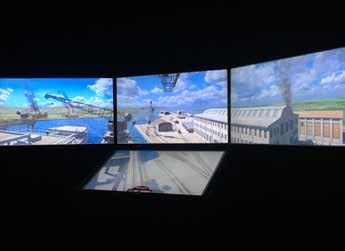
The greatest shipyards in Italy enclosed in a museum, and a museum turned into a shipyard to breathe new life into history, its sounds, images, and emotions that for decades have made the factory-city of Monfalcone, just outside Trieste, unique and alive. This is the MuCa, Museo della Cantieristica [lit. Museum of Shipbuilding Industry]: an extraordinary set-up and a reconstruction of the Time Line illustrating the development of shipyards in the area of Panzano and its territory.
Here you can enter the sensory tunnel and find yourself catapulted into the shipyard atmosphere and sounds; you can play with the crane simulator; and you can listen to the voices of the six lead figures of the local ship building history, such as Callisto Cosulich, Dante Fornasir, Egone Misso, Niccolò Costanzi, Tranquillo Marangoni, and Elda. Here you can admire the scale models of cruise ships and artworks that used to decorate their interiors, created by great artists, such as Zoran Mušič, Vito Timmel, Marcello Mascherini. And,
eventually, you may let yourself tear up standing in front of the Memorial dedicated to asbestos victims.
The museum collection is displayed in the chambers of the former hotel Albergo Operai del Villaggio in Panzano, a secessionist-style building –similar to the Métropole hotel in Vienna– designed in the Twenties by engineer Fornasir to host unmarried shipyard workers.
The hotel had a 5,000 m 2 surface, 700 cell-like, heated rooms, 1,300 windows, and disquieting endless hallways that earned this building the name “hotel of the wolves”.
In Panzano you can also find Albergo Impiegati [lit. Clerks Hotel], a finer building that used to host the shipyard clerks. Also designed by Fornasir, this hotel had 120 bedrooms and covered a 2,000 m2 surface. Panzano’s subsequent additions included 150 houses and cottages, schools, parks, and a theatre.
The shipyards, inaugurated on 3rd April 1908, were an initiative of the Cosulich family, ship owners from the island of Lošinj (Croatia), who also founded the Cantiere Navale Triestino (CNT) in Monfalcone.
Visiting hours and guided tours of both the museum and the shipyards available at www.mucamonfalcone.it
ENGLISH TEXT
—
Il cantiere diventa museo e il museo si trasforma in cantiere, nella cittàfabbrica di Monfalcone.
29 TRIESTE LIFESTYLE IES N°5 — March 2019 Discover the city
A shipyard turned into a museum, and a museum turned into a shipyard in the factory-city of Monfalcone.

Still life has never been so tasty www.pastrovicchio.com rob@pastrovicchio.com @rob_strovich via carnaro 21 34145 trieste - italy (+39)3299617876 Client: ITALESSE
DINOSAURI
di /by Ilaria Romanzin
al mare
A Prehistoric walk by the sea
praticamente in riva al mare, a una manciata di chilometri da Trieste.
È il Villaggio del Pescatore e custodisce una meraviglia che fa brillare gli occhi ai bambini e stupire gli adulti perché è l’unico Sito Paleontologico d’ Italia dove sono stati ritrovati i dinosauri.
I fossili sono stati meticolosamente e scientificamente scavati, catalogati e preparati. Fra loro c’è una vera e propria star, scoperta negli anni ’90: Antonio, un adrosauro di 4 metri, praticamente completo, un unicum nel mondo della paleontologia. È possibile vederlo come si presentava in vita, seguendo la sua passeggiata fra il mare e il Carso triestino, realizzata con le informazioni scientifiche supportate dalla tecnologia. La visione in realtà aumentata permette di scattare finanche dei selfie, con Antonio ma anche grandi rettili volanti.
E le ricerche non sono finite. Nel 2018 è stato trovato Bruno, un fossile quasi completo di un dinosauro di oltre cinque metri, ripiegato su se stesso, con la coda ancora immersa nella roccia.
Nel Sito del Villaggio i “giovani paleontologi” possono partecipare alle tante attività proposte tutto l’anno dalla Cooperativa Gemina: laboratori, giochi, la scoperta delle uova di dinosauro, gli scavi e un’avventurosa caccia al tesoro, con immancabile premio finale.
ENGLISH TEXT
It’s right by the sea, a few kilometres from Trieste. It’s the Villaggio del Pescatore [lit. Fisherman’s Village] and holds a treasure that makes children’s eyes light up and adults surprised, because it’s the only paleontological site in Italy where dinosaurs have been found.
The fossils were scientifically dug out, catalogued and prepared. Among them there is a true star, discovered in the ’90s: Antonio, a 4-metre-long Hadrosaur, practically complete, a unique case in the world of palaeontology. You can see how he was when alive, following his walk between the sea and the Triestine Karst, thanks to scientific information supported by technology. This virtual reality enables you to take some selfies with Antonio and huge flying reptiles.
But research hasn’t finished yet. In 2018 Bruno was found, a five-metre long dinosaur, lying in a folded position with his tail still inside the rocks.
In the Village site, “young palaeontologists” can take part in the many activities scheduled all year round by the Cooperativa Gemina: workshops, games, dinosaur egg discovery, excavations, and an adventurous treasure hunt with a prize at the end.
E dopo la visita ai dinosauri? Si può scoprire la pace e la tranquillità del Villaggio, per esempio fermandosi a mangiare il pesce all’Ittiturismo, delizioso agriturismo praticamente sull’acqua. E con un po’ di fortuna, si possono incrociare le barche che tornano dalla pesca o i pescatori che tirano su le cozze dal mare per ripulirle. Il Villaggio è una manciata di case, nate attorno al 1950 con l’esodo dei pescatori dalle terre d’Istria. È a un passo dalle foci del fiume Timavo, che si possono raggiungere seguendo il sentiero Bratina, un percorso ricco di spunti storici e naturalistici. Da non perdere: il Museo della Storia e preistoria attorno al Timavo e la chiesetta di San Giovanni in Tuba.
And what can you do after visiting the dinosaurs? You can enjoy the peace and tranquillity of the Village, for example why not try some fish at the Ittiturismo (fish farm), a delicious restaurant practically on the water. And with a bit of luck, you can see the boats coming back from fishing or fishermen pulling up mussels from the sea to clean them. The Village consists of a few houses, built in the 1950s after the exodus of fishermen from Istria. It stands close to the Timavo river mouth, that you can reach walking along the Bratina path, a route full of historical and naturalistic spots. Don’t miss: The History and Prehistory Museum on the Timavo river and San Giovanni in Tuba church.

Il Villaggio del Pescatore –The Villaggio del Pescatore
–
—
Una passeggiata nella preistoria, in riva
È
31 TRIESTE LIFESTYLE IES N°5 — March 2019 Discover the city
PORTO VECCHIO
A passeggio
fra storia e architettura, prendendo il Porto Vecchio
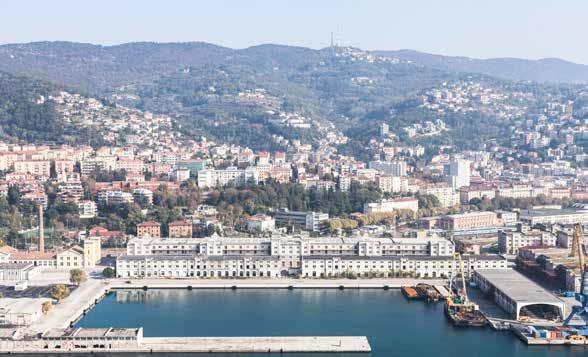
dal lato giusto — Get it on its right side.
A stroll among history and architecture
di /by Francesca Pitacco
32 TRIESTE LIFESTYLE IES N°5 — March 2019 Città da scoprire
Chi visita il Porto Vecchio spesso entra dal valico in Largo Città di Santos [1], ma non è la soluzione migliore. Anche le architetture – in particolare quando si tratta di complessi ideati come un organismo unitario – vanno prese per il verso giusto. E, nel nostro caso, il colpo d’occhio che il governo austriaco volle dare era quello di un magniloquente ingresso alla città.
Certo non esisteva la Strada Costiera (aperta nel 1928), ma la maggior parte di coloro che raggiungevano il grande porto franco lo faceva via mare e, per arrivare dalle banchine al centro cittadino, avrebbe lasciato i moli alle proprie spalle iniziando a percorrere uno di quei tre vialoni paralleli che inquadrano i palazzi neoclassici del Borgo eresiano, dominati dal Colle di San Giusto.

L’area di Porto Vecchio è estesa quanto una novantina di campi di calcio e da maggio 2017 è aperta ed è visitabile, pur permanendo l’inaccessibilità alle zone ancora interessate all’attività portuale.
Porto Vecchio fu un progetto molto ambizioso, che trovò le sue radici nella lontana proclamazione della città a Porto franco (1719) e nell’arrivo della linea ferroviaria meridionale da Vienna (1857). Trieste diventa così lo sbocco al mare di un grande Impero, i cui
traffici si intensificano di anno in anno. L’ingegnere francese Paulin Talabot, già responsabile del porto di Marsiglia, firma nel febbraio 1862 il “master plan” dell’area, che si compone di cinque moli, tre bacini chiusi da una diga foranea e lo spazio sufficiente per la costruzione dei magazzini. Questi ultimi verranno ideati a partire dal 1886 da Luigi Buzzi e Francesco Krause, i quali daranno vita a edifici funzionali, ma al contempo esteticamente gradevoli grazie a un ampio uso di colonnine in ghisa modanate e frontoni ornati.
Chi entra da Viale Miramare [2]–in auto o a piedi dopo essere sceso alle fermate della linea 6 al Cavalcavia o al Ferroviario – verrà accolto da una lunga sequenza di magazzini moderni prima di giungere ai bassi capannoni 27 [3] e 28 [4], che saranno trasformati in sale convegni per ESOF 2020. Il magazzino 27 è noto come Capannone Ford, perché al suo interno venivano assemblati parti di automobili e trattrici dell’omonimo marchio.
Sulla sinistra, c’è la Centrale Idrodinamica [5], con le sue due torrette e la grande ciminiera [6] di mattoni rossi. Vero cuore pulsante del porto, costruita tra il 1887 e il 1890, al suo interno (aperto in occasione di mostre
Porto Vecchio covers a surface of approximately 90 football fields and since May 2017 it’s open to the public.
L’area di Porto Vecchio è estesa quanto una novantina di campi di calcio e da maggio 2017
è aperta e visitabile. —
33 TRIESTE LIFESTYLE IES N°5 — March 2019 Discover the city
N
temporanee o contattando il Comune di Trieste) sono state restaurate quattro monumentali macchine a vapore che producevano l’energia per azionare le gru di banchina, attivare i montacarichi e le luci dei magazzini e muovere il sistema di apertura del ponte Verde all’inizio del Canal grande. Il tutto attraverso un ramificato sistema di tubazioni che corre sotto il livello del mare per impedire che il gelo bloccasse l’attività portuale. Una volta arrivata l’energia elettrica, le caldaie della Centrale vennero dismesse a favore della produzione derivante dalla Sottostazione elettrica, posizionata nella bella e poco distante struttura a intonaco bianco e rosso, risalente al 1913.

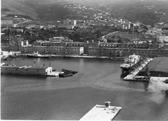
Il fronte mare è riservato al bacino 1 [7], mentre alle sue spalle si snodano gli edifici più interessanti del Porto. Immediatamente a ridosso della riva si trovano gli hangar 24 [8] e 25 [9], fino agli anni Ottanta usati come terminal per gli animali vivi: è possibile ancora scorgere mangiatoie e abbeveratoi che dividono gli spazi interni. Alle loro spalle, c’è il grandioso magazzino 26 [10], futuro Museo del Mare, dove attualmente è esposta una spettacolare selezione degli oggetti dell’archivio del Lloyd
Triestino. All’esterno, sono notevoli i ballatoi e molto interessanti i “perrons”, alti marciapiedi che rendevano più agevoli il carico e lo scarico delle merci dai treni o dai veicoli. Dietro il magazzino 26, alquanto diruta, è visibile la locanda [11] disegnata da Giorgio Zaninovich.
Da qui si prende un lungo viale che corre tra il retro dei magazzini e la ferrovia. A quest’altezza, ma in area portuale, c’è il celebre Magazzino 18 [12], raccontato in teatro da Simone Cristicchi. Al suo interno è custodita una parte dei beni lasciati dagli esuli istriani dopo la Seconda Guerra Mondiale. Dalle foto d’epoca si evincono le destinazioni dei magazzini: mondatura del caffè, deposito cotone, granaglie, metalli, legname.
L’infilata si chiude con l’ingresso in città, segnalato dalla torre piezometrica [13] e dal muro di recinzione, ma un ultimo sguardo a Porto Vecchio cade sul Molo IV [14], dal quale si dominano con un solo colpo d’occhio i grandi hangar, trasformati fin dal 1924 per accogliere le celle frigorifere della società di navigazione Cosulich. Alcuni dei vecchi edifici dismessi oggi sono trasformati in Magazzino delle Idee, [15] dove vengono allestite mostre ed esposizioni.
2 3 5 6 10 9 8 7 11 12 4 34 TRIESTE LIFESTYLE IES N°5 — March 2019 Città da scoprire
Visitors usually enter Porto Vecchio from Largo Città di Santos [1] – yet, this is not the right side. Architectural complexes – especially when they are designed as a whole – require you to get them on their right side. In this case, the intended vista, as devised by the Austro-Hungarian Empire’s architects, was that of a grandiose city entrance.
Although the Strada Costiera [lit. coastal road] did not exist at the time (it was inaugurated only in 1928), those who reached Trieste’s Porto Franco usually did so by sea, eventually entering the city from one of the parallel avenues lined with neoclassical buildings of Borgo Teresiano, under the shadow of the Colle di San Giusto hill.
Porto Vecchio covers a surface of
approximately 90 football fields – and since May 2017 it is open to the public, except for the areas that still host port-related activities.
Porto Vecchio was quite an ambitious project, born when the city of Trieste was named free-trade port (1719), and further developed when the city was reached by the southbound railway starting in Vienna (1857). Trieste was the only sea access of a great empire, that saw its trade exchanges increase year after year. In February 1862 French engineer Paulin Talabot, who had supervised the construction of Marseilles port, signed the area’s “master plan”, that included five docks, three closed breakwater basins, and a space dedicated to the construction of warehouses. The latter were designed in 1886 by Luigi Buzzi and Francesco Krause, who created functional, yet aesthetically pleasing buildings ornate with cast-iron small columns and decorated pediments.
Accessing it from Viale Miramare [2]– by car or by foot, after taking bus no. 6 at either the Cavalcavia or Ferroviario stops, you will be greeted by a long line of modern-looking warehouses before
reaching low depots no. 27 [3] and 28 [4], turned into congress halls for ESOF 2020. Depot 27 is also known as Ford Warehouse, as it used to host part of the assembly chain of Ford automobiles and tractors.
On the left-hand side you can see the hydrodynamic plant [5] , with its high red-brick smokestack [6] and two square towers at the sides of the main facade: real beating heart of the port, it was built between 1887 and 1890 (open to the public during temporary displays or upon appointment with Trieste’s municipality office). It currently hosts four renovated monumental steam machines that used to feed the dock cranes, activate the lift gates, lit the warehouse, and open the Ponte Verde [lit. green bridge] to the Grand Canal. Energy was supplied through a network of underwater pipelines that prevented ice from compromising port-related activities. Once electricity came along, the plant boilers were deactivated and replaced by the electric substation, in the nearby, beautiful white-red plaster building, dating back to 1913.
The waterfront is dominated by basin no. 1 [7], behind which the most
ENGLISH TEXT
1 13 15 14
—
Il magazzino 27 è noto come Capannone Ford, perché al suo interno venivano assemblati parti di automobili e trattrici dell’omonimo marchio.
35 TRIESTE LIFESTYLE IES N°5 — March 2019 Discover the city
Depot 27 is also known as Ford Warehouse, as it used to host part of the assembly chain of Ford automobiles and tractors.
La Centrale Idrodinamica
The hydrodynamic plant, was the real beating heart of the port. It currently hosts four monumental steam machines that used to feed the dock cranes.

interesting port’s buildings extend: first of all, hangars no. 24 [8] and no. 25 [9], accommodating live cattle until the Eighties; the inner spaces are still divided by abandoned mangers and drinking troughs. Beyond them lies hangar no. 26 [10], soon-to-be the Sea Museum, currently displaying a spectacular selection of archive items of Trieste’s section of Österreichischer Lloyd. The outside walkways are matched by the network of perrons, elevated pavements built to facilitate loading and unloading operations of trains and vehicles. Beyond hangar no. 26 visitors can still make out the ruins of the inn designed by Giorgio Zaninovich [11]
Taking the long avenue running between the warehouses and the railway,

you can reach hangar no. 18 [12], subject of Simone Cristicchi’s theatre monologue. It contains some of the properties of Istrian migrants who left Trieste after the Second World War. Old pictures suggest each warehouse’s purpose: coffee husking, cotton storing, and repository of grain, metal, and wood.
Upon reaching the surge tank [13] and the end of the fencing wall, this itinerary eventually leads into the city – yet one last gaze must be thrown at Molo IV [lit. fourth dock] [14], overlooking the hangars, that were turned into refrigerating rooms by the Cosulich sailing company in 1924. Some of these old buildings today host the Magazzino delle Idee [lit. workshop of ideas] [15], displaying temporary exhibits.
era il vero cuore pulsante del porto. Ospita al suo interno quattro monumentali macchine che producevano l’energia per azionare le gru di banchina.
—
36 TRIESTE LIFESTYLE IES N°5 — March 2019 Città da scoprire
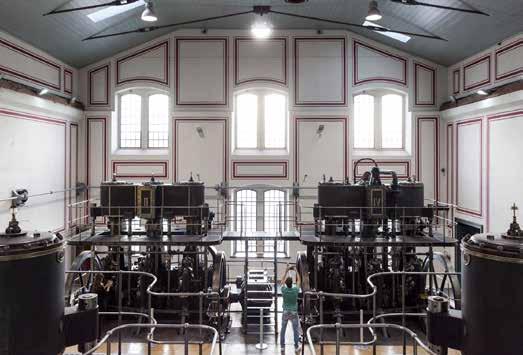
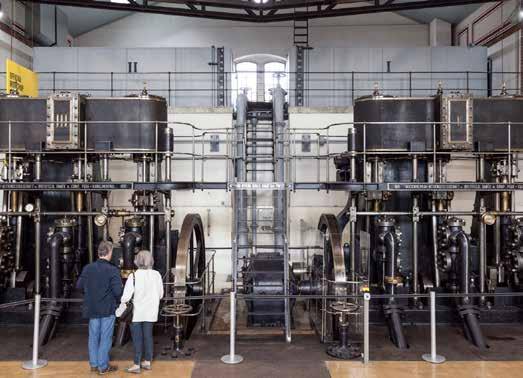
37 TRIESTE LIFESTYLE IES N°5 — March 2019 Discover the city
TRE SECOLI DI PORTO FRANCO

38 TRIESTE LIFESTYLE IES N°5 — March 2019 Portfolio
Foto da / Courtesy of Autorità di Sistema Portuale del Mare Adriatico Orientale
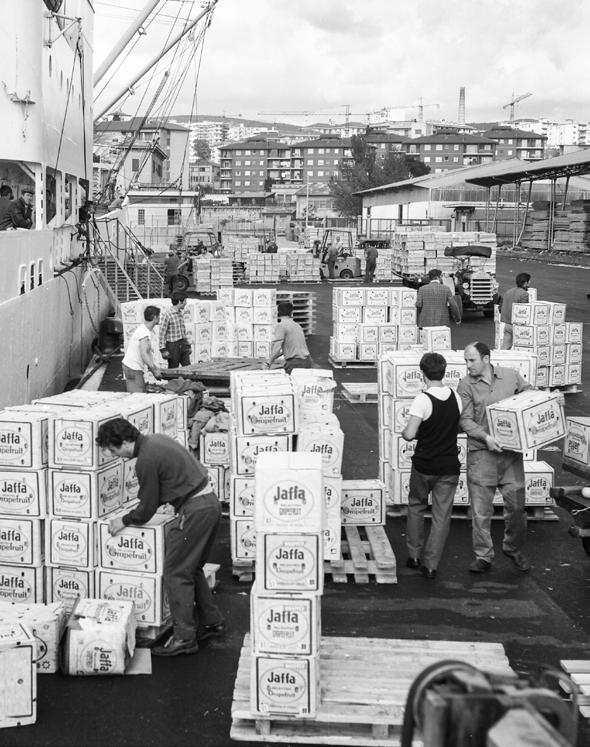
39 TRIESTE LIFESTYLE IES N°5 — March 2019 Portfolio
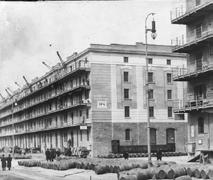

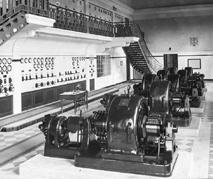

40 TRIESTE LIFESTYLE IES N°5 — March 2019 Portfolio
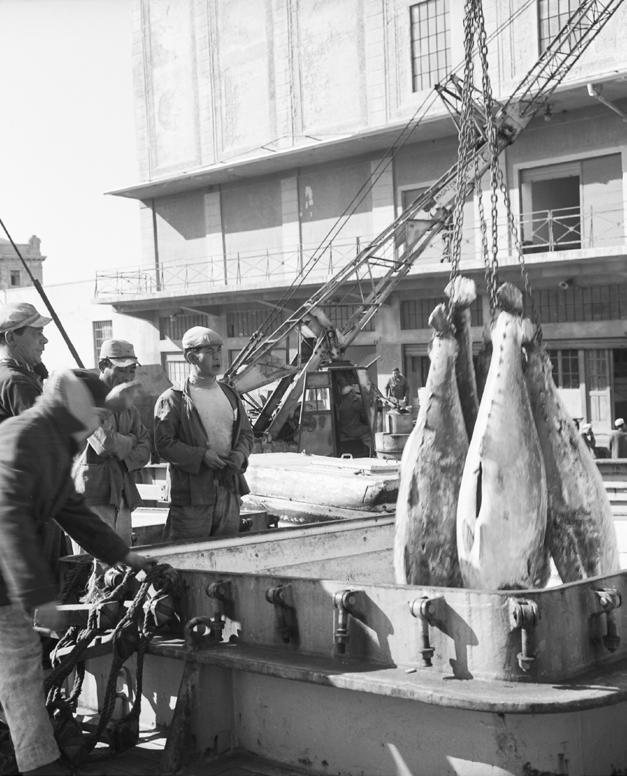
41 TRIESTE LIFESTYLE IES N°5 — March 2019 Portfolio
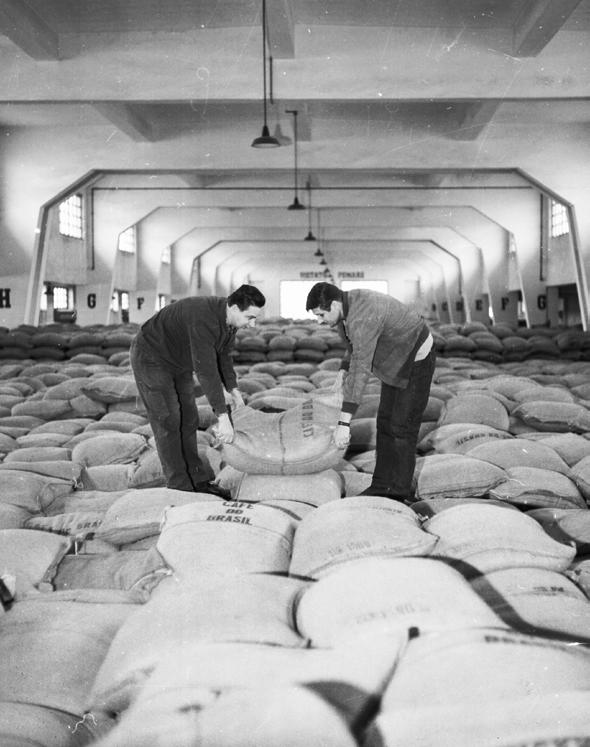
42 TRIESTE LIFESTYLE IES N°5 — March 2019 Portfolio


43 TRIESTE LIFESTYLE IES N°5 — March 2019 Portfolio
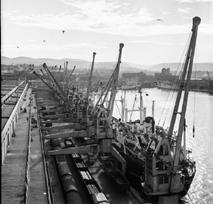

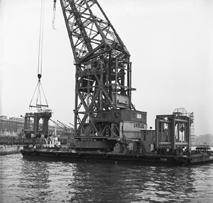
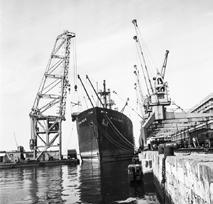
44 TRIESTE LIFESTYLE IES N°5 — March 2019 Portfolio
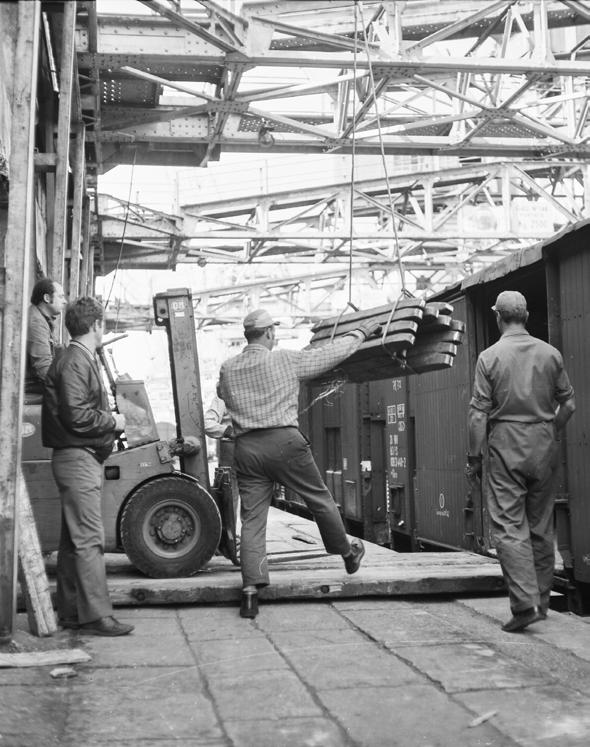
45 TRIESTE LIFESTYLE IES N°5 — March 2019 Portfolio
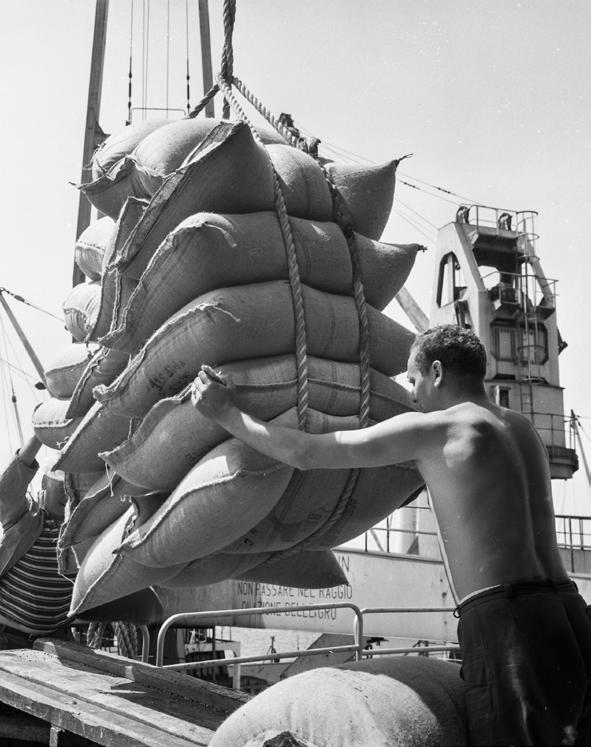
46 TRIESTE LIFESTYLE IES N°5 — March 2019 Portfolio
Il 18 marzo 1719 l’imperatore
Carlo VI ha istituito il Porto Franco di Trieste. Una “patente” che ha mutato il corso della storia della città e, in effetti, anche dell’impero d’Asburgo prima e dei mercati europei poi. In questi tre secoli, lo scalo giuliano ha avuto un ruolo fondamentale nelle relazioni commerciali tra Vecchio Continente e Oriente. Basti pensare allo sviluppo dei traffici intervenuto con l’apertura del canale di Suez. La stessa fondazione di Trieste dipende dalla scelta di Carlo VI e di Maria Teresa di eleggervi “il” porto dell’Impero, un porto che ha suscitato l’impianto a Trieste delle più varie e qualificate imprese economiche. Tra di esse, possiamo ricordare alcune delle maggiori compagnie assicurative della storia italiana ed europea, nonché la cantieristica oggi leader mondiale nel settore crocieristico. Non di meno dovremo ricordare che la presenza dello scalo ha
determinato l’avvio di attività specifiche come l’importexport di caffè.
Tutto parla del porto e del mare a Trieste, pensiamo ancora alla creazione dell’Imperial-regia Accademia di commercio e nautica, che fu il nucleo generatore dell’Università di Trieste.
Il porto di Trieste oggi sta vivendo una fase di straordinario rilancio, assumendo un ruolo primario a livello nazionale (primo scalo italiano per traffico e movimentazione ferroviaria) e internazionale (snodo di riferimento in Europa per la Nuova Via della Seta).

L’attualizzazione dello status giuridico di Porto Franco, punto di forza unico di Trieste, va in questo senso, anche con il potenziamento della rete infrastrutturale che, come mi piace ricordare, è stata in larga parte concepita e realizzata già in età imperiale, con fasci di binari capillarmente presenti in ogni banchina e nella parte retroportuale.
On 18th March 1719, Emperor Charles VI established the Free Port of Trieste, a “licence” that changed not only the course of the city’s history but also that of the Hapsburg Empire first and later of the European markets. In these past three centuries, the Julian port has played a central role in trade relations between the Old Continent and the East: we need only consider, for example, the expansion of trade brought about by the opening of the Suez Canal. The foundation of the free port of Trieste in the 18th century resulted from the decision of Charles VI and Maria Theresa to designate Trieste as “the” port of the Empire, a port that was to attract to the city the most diverse and qualified economic enterprises. Among them, we can recall some of the major insurance companies in the history of Italy and Europe, and the leading shipbuilding company in the cruise ship industry worldwide. Equally
important, the presence of the port spurred the development of specific activities like coffee imports/exports and industrial coffee processing.
Everything in Trieste talks about the sea and the port –just consider, for example, the Imperial-Royal Academy of Commerce and Navigation, the original core of the University of Trieste. The port of Trieste is now experiencing an extraordinary revival, taking on a central role both nationally (first Italian port for railway traffic and transport) and internationally (reference node in Europe for the New Silk Road). Hence its renewed legal status of Free Port, a point of strength that is absolutely unique to Trieste. Hence the upgrading of the infrastructural network, largely planned and realised during the Hapsburg Empire: its multiple rail tracks that are widely present on every quay and within the intermodal terminal area.
47 TRIESTE LIFESTYLE IES N°5 — March 2019 Portfolio
Zeno D’Agostino Presidente dell’Autorità di Sistema Portuale del Mare Adriatico Orientale
TEATRO
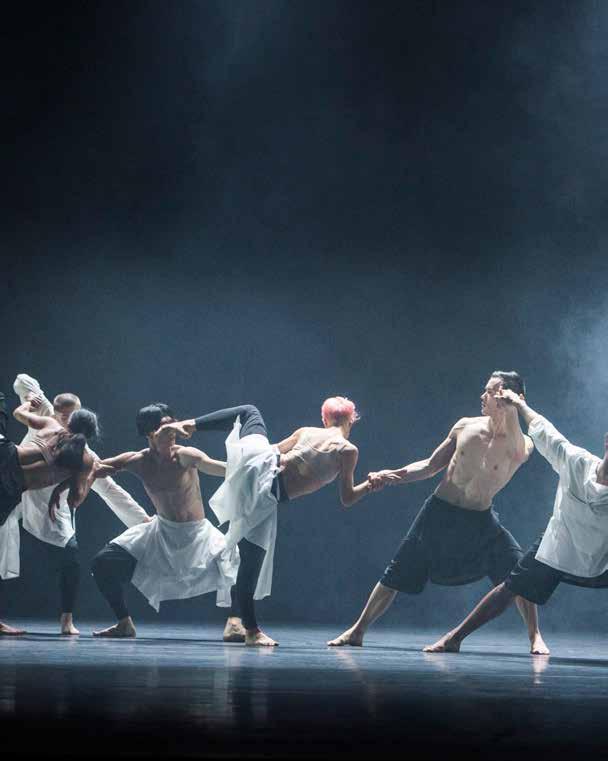
48 TRIESTE LIFESTYLE IES N°5 — March 2019 Città da vivere
Magia e modernità nel fascino del Politeama Rossetti
— Magic and innovation within the charm of Politeama Rossetti theatre
Trieste città teatrale: lo è stata e lo è, per radicamento culturale e tradizione storica, con un pubblico folto, appassionato e curioso, anche di fronte all’innovazione e alle proposte più insolite.
Il simbolo è il Politeama Rossetti, dal 1878 preziosa cornice delle più diverse forme di spettacolo e di artisti di assoluto valore: vi hanno diretto Franz Lehar e Gustav Mahler, vi ha cantato Maria Callas e vi hanno recitato Sarah Bernhardt e Adelaide Ristori, Vittorio Gassman e Marcello Mastroianni, solo per citarne alcuni.
Il Teatro Stabile del Friuli Venezia Giulia, che ha sede fin dal 1969 in questo edificio storico e contemporaneamente tecnologicamente all’avanguardia, vi organizza stagioni che, fedeli all’anima storica del Politeama, all’amore per la produzione e la prosa, si aprono a generi diversi, portando a Trieste titoli e nomi di altissimo livello internazionale.
La conferma è in questa primavera, a partire dallo spettacolo inedito con cui Roberto Bolle, che già più volte ha incantato il pubblico del Rossetti, ritorna a Trieste, offrendo alla città uno straordinario “An Evening with Roberto Bolle” per due serate da non perdere il 24 e 25 aprile.

49 TRIESTE LIFESTYLE IES N°5 — March 2019 Live the city
C’è poi Lino Guanciale (il protagonista della fiction “La porta rossa”, girata proprio a Trieste) che nell’edizione teatrale de “La classe operaia va in paradiso” interpreta Lulù Massa, diretto da Claudio Longhi (dal primo al 5 maggio). Un elegante Maestro quale Glauco Mauri, assieme a Roberto Sturno, sarà protagonista in “En attendant Beckett” (fino al 12 maggio alla Sala Bartoli).
La vasta sala maggiore (1530 posti) ospiterà “Autobiography” (10 aprile), balletto che il geniale coreografo inglese Wyne McGregor ispira al genoma umano, tema stimolante in una Trieste che nel 2020 sarà “Capitale europea della scienza”, e il musical “School of Rock” sulla partitura del grande Andrew Lloyd Webber.
La musica sarà protagonista indiscussa del finale di stagione, con la chiusura “esplosiva”, a fine maggio, degli “Stomp”. Li precederanno artisti della caratura dei Jethro Tull, la band simbolo del progressive rock (1 aprile), il raffinato Ludovico Einaudi (11 aprile), Goran Bregovic (il 12 aprile) con un’orchestra di 18 elementi nel concerto “Three letters from Sarajevo”, e poi l’élite della musica italiana, da Elisa (19, 20 aprile e 31 maggio) a Manuel Agnelli (27 aprile) dalla PFM a Paolo Conte, protagonista il 18 maggio di una serata a sostegno dell’AIRC.
Biglietti e info sul sito www.ilrossetti. it o allo 040-3593511.
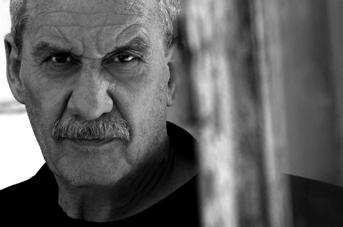
Trieste the city of theatre: both in the past and the present, for cultural and historic tradition, attracting a wide, passionate, and interested audience, even when it comes to innovation and unusual stage choices.
Trieste’s theatre symbol is Politeama Rossetti, invaluable host to the most diverse forms of theatre and outstanding performers since 1878: it saw directors as Franz Lehar and Gustav Mahler, while its boards were threaded by world-famous artists, such as Maria Callas, Sarah Bernhardt, Adelaide Ristori, Vittorio Gassman, and Marcello Mastroianni, just to name a few.
The Teatro Stabile del Friuli Venezia Giulia, one of Italy’s major public theatres, active here since 1969, uses contemporary technology to stage its whole seasons, faithful to its traditional love for production and prose, bringing to Trieste internationally renowned plays and actors.
Witness 2019 original and mustsee show by Roberto Bolle, celebrating one of his many appearances at the Politeama Rossetti, this time offering an extraordinary “Evening with

ENGLISH TEXT
Nomi di altissimo livello internazionale con la musica protagonista indiscussa del finale di stagione.
—
50 TRIESTE LIFESTYLE IES N°5 — March 2019 Città da vivere
Music will be the crowning jewel of the whole season, with the Stomp performing at the end of the season.
Roberto Bolle”, for two nights in a row, on 24th and 25th April. There is also Lino Guanciale (main character in the TV fiction La porta rossa [The Red Door], filmed in Trieste), who plays the role of Lulù Massa in La classe operaia va in paradiso [lit. The working class goes to heaven] directed by Claudio Longhi (from 5th May). The elegant Maestro Glauco Mauri, together with Roberto Sturno, will play in “En attendant Beckett” (Sala Bartoli, until 12th May).
The main hall (1,530 seats) will host the show “Autobiography” (10th April), a ballet choreographed by English master Wayne McGregor, inspired by the human genome, in the city that will be European Capital of science in 2020, as well as the musical “School of Rock”, based on the music by Andrew Lloyd Webber.
Music will be the crowning jewel of the whole season, with the Stomp performing at the end of the season. They will be introduced by artists of caliber, such as Jethro Tull, symbol of progressive rock (1st April), Ludovico Einaudi (11th April), Goran Bregovic (12th April), with an 18-element orchestra playing the


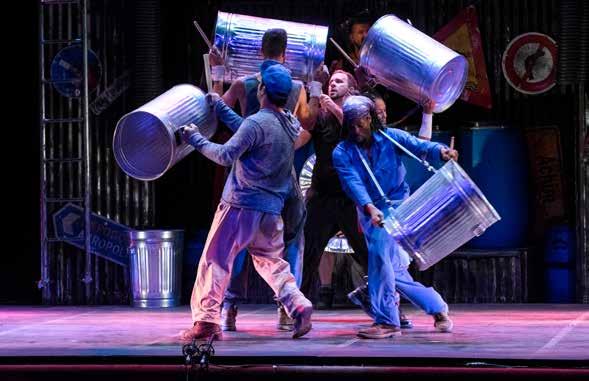
concert “Three letters from Sarajevo”, and finally the very élite of Italian music, ranging from Elisa (19th and 20th April, and 31st May) and Manuel Agnelli (27th April), to PFM and Paolo Conte, who, on 18th May, will feature in an event supporting AIRC [lit. Italian Association for Cancer Research].
Tickets and information at www.ilrossetti.it tel. no. 040-3593511.
51 TRIESTE LIFESTYLE IES N°5 — March 2019 Live the city
TOP FIVE
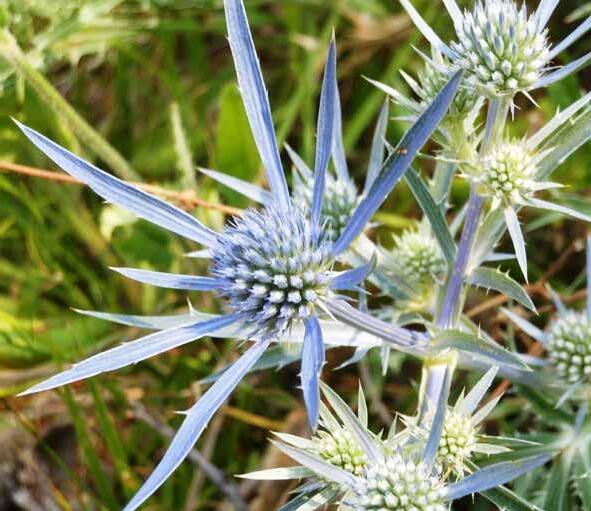
GREEN
52 TRIESTE LIFESTYLE IES N°5 — March 2019 Città da vivere
Città della Barcolana, Città della Scienza, Città del Caffè, ma –forse– anche Città del Verde e dei Giardini, anche se poco conosciuti e probabilmente poco apprezzati. Con l’eccezione, ovviamente, del grande e sontuoso parco che circonda il castello di Miramare, un vero e proprio luogo del cuore per i triestini, come i giardini che incorniciano dimore storiche come Villa Cosulich, Villa Sartorio, Villa Revoltella o Villa Engelmann. Più nascoste, invece, altre piccole oasi verdi, come il giardino storico di via Catullo o il colorato giardino di via Carpineto a Valmaura.
E non poteva che svolgersi a Trieste la più garbata e affascinante delle manifestazioni florovivaistiche, Horti Tergestini, in calendario quest’anno dal 20 al 22 di aprile nella stupenda cornice del Parco di San Giovanni, una vera e propria rassegna di bellezza in un luogo fortemente simbolico, l’ex ospedale psichiatrico, culla della rivoluzione basagliana e ora Parco pubblico sempre aperto e visitabile, che punta a diventare uno dei roseti più importanti d’Europa, grazie alle sue variegate collezioni di rose. Forse anche per questo, uno degli incontri fissi degli Horti Tergestini è l’attempata signora inglese delle rose: viene ogni anno da oltre Manica, sempre pronta a donare preziosi consigli e a inebriare i visitatori con il profumo di una delle sue romantiche rose antiche.
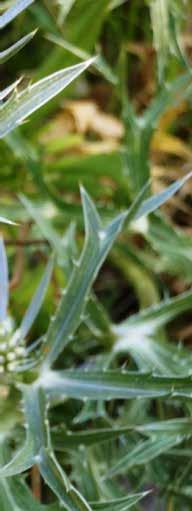
ENGLISH TEXT
City of Barcolana, City of Science, City of Coffee, and –why not– City of Green and of Gardens, although less known (and probably less appreciated) compared to the other epithets.
The only exception is the huge and luxurious park surrounding Miramare castle, one of Triestini’s favourite places, together with the gardens of historic residences, such as Villa Cosulich, Villa Sartorio, Villa Revoltella, and Villa Engelmann. Trieste, however, has more than one green oasis, just a few steps away from the main touristic itineraries, such as the historic garden in Via Catullo or the colourful garden in Via Carpineto, in the area of Valmaura.
It is only natural, therefore, that Trieste should play host to the most graceful and fascinating event of the plants and flowers’ world: Horti Tergestini. This year, the festival will take place from 20th to 22nd April within the gorgeous framework of San Giovanni Park, a symbolic venue that used to host Trieste’s pshychiatric hospital where Franco Basaglia’s reform was born. Today the park is open to the public and it aspires at becoming one of the most important rose gardens in Europe, thanks to its rich rose collection.
Perhaps this is why one of the regular guests featured during the event Horti Tergestini is the venerable English lady of the roses: every year she crosses the Channel to share her precious tips and delight the festival visitors with the scent of one of her antique roses.
/
53 TRIESTE LIFESTYLE IES N°5 — March 2019 Live the city
di
by Isabella Franco
Miramare
È il parco storico di Trieste, amatissimo dai suoi cittadini e tappa obbligata per ogni turista. Il parco di Miramare si estende per 22 ettari, sul promontorio roccioso di Grignano. È stato ideato tra il 1856 e il 1860 da Massimiliano d’Asburgo. Nella zona est prevale la sistemazione “a bosco”, che asseconda l’orografia del luogo: alberi alternati a spazi erbosi, sentieri tortuosi, gazebi e laghetti, ripropongono i dettami romantici del giardino paesistico inglese. La zona sud ovest, protetta dal vento, accoglie aree geometricamente impostate, come nel caso del giardino all’italiana davanti al “Kaffeehaus” o delle aiuole ben articolate intorno al porticciolo.
It is Trieste historical park, most beloved by locals and a must for every tourist. It covers a 22-hectar surface on the rocky promontory of Grignano. It was created between 1856 and 1860, based on a design by Maximilian I of the House of Habsburg. Its eastern side is arranged as the typical English landscape garden, in line with the local orography: sweeps of gently rolling lawns set against groves of trees, windy pathways, gazebos, and lakes. Shielded from the wind, the south-western side is divided into more formal, symmetrical areas, like the Italian Garden in front of the “Kaffeehaus”, or the flowerbeds surrounding the marina.
Carsiana
Si trova all’interno di una dolina a Sgonico, a 18 chilometri da Trieste. Conta circa 600 specie floristiche in 5 mila metri quadrati, un’area nella quale sono naturalmente rappresentate tutte le principali conformazioni geomorfologiche del territorio del Carso, una vera e propria sintesi del paesaggio carsico. È il Giardino Botanico Carsiana, nato nel 1964 e oggi abbellito dalle coreografie di molte farfalle. Ci sono una “foresta” di querce, una zona umida, un giardino roccioso, gli arbusti mediterranei e, proprio all’ingresso, “l’orto dei semplici”, ovvero coltivazioni di piante officinali di vario tipo, fra cui l’artemisia, la melissa, il cren, il finocchio. Il momento migliore per visitarlo, con tutte le sue fioriture, è proprio ora, da maggio a luglio.
It lies in a sinkhole of the Karst Plateau in Sgonico, only 18 km from Trieste. Five thousand square metres that host more than 600 plant species, in an area representative of all the main geomorphological formations of this territory and its peculiar landscape: it is the Carsiana botanical garden, founded in 1964 and adorned today by the graceful coreography of its butterflies. There is an oak wood, a wet zone, a rocky garden, Mediterranean shrubs, and, right at the entrance, the “garden of the humble”: a patch of ground were medicinal herbs are grown, including sagebrush, lemon balm, horseradish, and fennel. The best time to visit the Carsiana is between late spring and early summer, from May to July, when its plants are in full bloom.
Orto Botanico
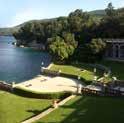

Come una banca della poesia e della spensieratezza, con la sua struttura anarchica e la variegata popolazione botanica, chissà quante preghiere e invettive di studenti in crisi di nervi avrà sentito! Il Civico Orto Botanico nasce nel 1842 nella zona di Chiadino per sperimentare la possibilità d’attecchimento del pino nero austriaco sul Carso, un esperimento affidato al farmacista botanico Bartolomeo Biasoletto. Tra le particolarità di questo giardino, tra il sentiero delle piante velenose e lo spazio dedicato alle specie tintorie, vi è un’aiuola di piante magiche, che si chiama Florilegio, disegnata su una trama di suggestioni esoteriche, dove sono raccolte le principali piante dai significati magici, religiosi e mitologici.
A repository of poetry and light heartedness, with its anarchic structure and infinite varieties of plants, if these grounds could speak, they would certainly recount many a prayer –and more than one rant– uttered by unnerved students. The Civico Orto Botanico [lit. city’s botanic garden] opened in 1842 in the area of Chiadino as a testing ground for the rooting of Austrian pine on the Karst Plateau – an experiment conducted by botanic chemist Bartolomeo Biasoletto. Among the many amenities of this garden there is a path of poisonous plants, a patch dedicated only to dyeing plants, and a flowerbed of magical plants called Florilegio, inspired by esoteric notions, featuring the most significant plant varieties with magical, religious, and esoteric meaning.
2
–
1
–
3
–
2 Giardino Botanico
54 TRIESTE LIFESTYLE IES N°5 — March 2019 Città da vivere
1
Carsiana Miramare
Giardino San Michele

È uno degli scorci verdi più belli e nascosti della città. Lo testimoniano i molti curiosi che lo cercano, cartina alla mano. Si trova alla fine della scalinata che viene dalla chiesa di San Giusto, tra la via della Cattedrale, a monte, e la via San Michele, a valle, e vi si incontra una fontana con due scalinate e un terrazzamento. Il giardino si sviluppa su due livelli, con un piano delimitato da un pergolato di colonne colorate, aiuole fiorite e un’ampia area di sosta all’ombra di un grande platano. Vi si riconoscono alberi di albizia, cryptomeria, bagolaro, ginepro e thuia. La zona superiore, ombrosa e tranquilla, è adatta al relax, magari in compagnia di un buon libro, mentre la zona dedicata ai bimbi è colorata e animata da tante iniziative interessanti.
It is one of the most beautiful, yet less known green spots of Trieste – as witnessed by many a tourist looking for it, maps in their hands. It is located at the end of the staircase of San Giusto, climbing up the hill between Via della Cattedrale, on the hill side, and Via San Michele, on the slope end, and leading to the entrance, marked by a fountain, surrounded by two further staircases and a terracing space. The garden has two levels, separated by a terrace covered by an arbour of coloured columns, blooming flowerbeds, and a resting area shaded by a great sycamore. The park’s numerous varieties of trees include pink silk trees, cryptomerias, lote trees, juniper trees, and northern white cedars. The upper level, shady and quiet, is the perfect spot for relaxation, while the lower level is dedicated to junior visitors, with its colours and countless initiatives.
Villa Revoltella
Qualche anno fa vinse pure il titolo di parco più bello d’Italia. In origine aveva la funzione di adornare lo chalet di proprietà del barone Pasquale Revoltella, imprenditore e finanziere di origine veneziana. Oggi il parco è percorribile grazie ai vialetti pavimentati, intervallati da aiuole fiorite e prati ben curati su cui dominano alberi secolari. All’interno ci sono diversi manufatti, tra cui una bella chiesa in pietra carsica e un’imponente serra di vetro e ghisa con un tipico giardino all’italiana. Le rose antiche ornano la parte retrostante dello chalet, mentre antichi vasconi pieni di lavande e camelie incorniciano un’area riservata ai più piccoli. L’entrata al parco è libera.
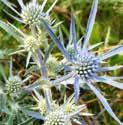
Just a few years ago it won Italy’s most beautiful park award. Its creators only meant to decorate the chalet owned by baron Pasquale Revoltella, enterpreneur and financier of Venetian origin. Today the park is open to the public: visitors may explore it through a network of paved walkways, embellished by blooming flowerbeds and well-tended meadows, dominated by centuries-old trees. The park’s attractions include a delightful little church with Karststone walls and a majestic greenhouse of glass and cast iron, hosting a typical Italian garden. The chalet’s backyard is populated by antique roses, while the old tubs of lavender and camellias decorate the area dedicated to junior visitors. Entrance to the park is free of charge.
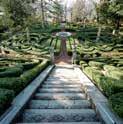
4
–
5
–
3 5 4
Giardino San Michele
Villa Revoltella
55 TRIESTE LIFESTYLE IES N°5 — March 2019 Live the city
Orto Botanico
Nella stupenda
San Giovanni
Dai luoghi della sofferenza a quelli della bellezza: il parco di San Giovanni racconta di una trasformazione possibile. In quest’area, nel 1908, fu inaugurato l’ospedale psichiatrico di Trieste. Negli anni Settanta il Parco diventa il luogo dell’innovazione e del cambiamento nel campo della psichiatria, grazie a Franco Basaglia: l’ospedale e il Parco si aprono alla città, i malati sono liberi di uscire e i cittadini di entrare.

Oggi questo parco di circa 22 ettari che ospita 40 edifici di varie dimensioni, è un omaggio alla rosa, scelta come simbolo di unione tra passato e presente. Ve ne sono più di 3000 varietà, provenienti da tutto il mondo, antiche e moderne, alcune davvero rare. Se visitate il parco in questa stagione, non mancate lo spettacolo del glicine in fiore, proprio davanti al bar. [IF]

From affliction to beauty: San Giovanni Park tells a story of transformation and possibility. In 1908 the Park saw the inauguration of Trieste’s psychiatric hospital. It was in the Seventies, however, that this area turned into a place of innovation and change for psychiatry, thanks to Franco Basaglia: hospital and Park merged with the city, with patients free to go out and citizens free to come in. Today this 22-hectar Park hosts 40 buildings of various sizes, and serves as a tribute to roses, symbolic trait-d’union between past and present. There are more than 3,000 rose varieties from all over the world, antique and modern, some quite rare. If you are planning to visit the Park in spring, do not miss the wonder of the blooming wisteria, right in front of the café.
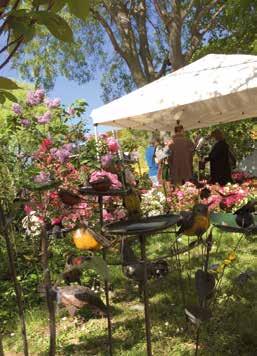
cornice del Parco di San Giovanni si svolge la più garbata e affascinante delle manifestazioni florovivaistiche, Horti Tergestini, una vera e propria rassegna di bellezza. —
56 TRIESTE LIFESTYLE IES N°5 — March 2019 Città da vivere
The wonderful setting of San Giovanni Park play’s host to the most graceful and fascinating event of the plants and flowers’ world: Horti Tergestini.
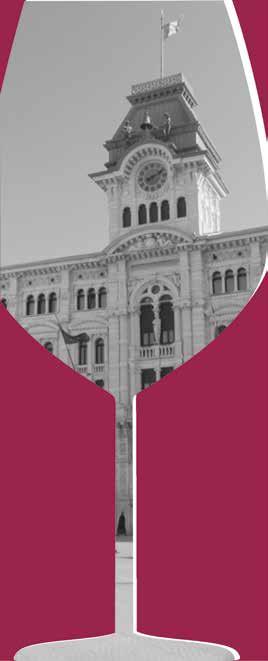
L’Enoteca Bischoff, nel cuore di Trieste da oltre 240 anni, vanta un assortimento di vini prestigiosi, bottiglie da collezione e la più ampia selezione di VINI DEL TERRITORIO Più di 3000 etichette e più di 15.000 bottiglie esposte rendono Bischoff l’enoteca più fornita della città e una delle più complete della regione il vino dal 1777 a Trieste. ENOTECA BISCHOFF VIA GIUSEPPE MAZZINI, 21 - TRIESTE +39 040 631422 info@bischoff.it www.bischoff.it seguici anche su DAL LUNEDI AL SABATO 9:30 / 13:00 16:00 / 19:30
LINK FESTIVAL
Link, festival del buon giornalismo, taglia il traguardo della sesta edizione, spin off del Premio giornalistico internazionale Marco Luchetta giunto al traguardo dell’edizione numero 16. L’appuntamento nella tensostruttura coperta capace di oltre 200 posti a sedere che sarà allestita in piazza Unità d’Italia, è fissato dal 10 al 12 maggio. Evanto inaugurale la sera del 9. La Fincantieri Newsroom, dopo lo straordinario successo della passata edizione con il tutto esaurito per le decine di incontri in programma, riproporrà in questa sesta edizione più di una ventina di panel della durata di 45 minuti l’uno, tra le 10 e le 13 e dalle 16 alle 21, con ingresso libero fino ad esaurimento posti. Invitati anche quest’anno giornalisti delle più prestigiose testate italiane ed estere, volti della televisione, scrittori e grandi firme del mondo della comunicazione. La grande novità di questa edizione sarà la presenza dei vincitori della 16ma edizione del Premio giornalistico internazionale Marco Luchetta che presenteranno i servizi ed i reportage scelti nelle cinque categorie del Premio da una qualificata giuria, presieduta dal direttore di Rainews24 Antonio Di Bella.
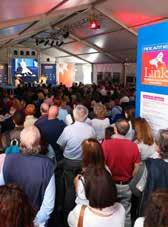
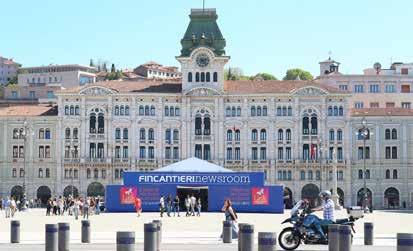
ENGLISH TEXT
Link, festival of good journalism, has been running for the 6th year now, born a spin-off of the Marco Luchetta International Press Award, at its 16th edition. The event will be held from 10 to 12 May inside a large marquee set up in Piazza Unità and accommodating over 200 seats. The opening event will take place on 9 May evening. The Fincantieri Newsroom, after last year’s extraordinary success with a fully booked programme, will play host to over 20 panels, 45 minutes each, from 10 am to 1 pm and from 4pm to 9pm, admission is free, subject to availability. Again this year the event will feature journalists from the most prestigious Italian and foreign newspapers, TV personalities, writers and top names of the world of communication. And there’s a new addition to the programme: the winners of the 16th edition of the Marco Luchetta International Press Award will present their articles, videos and photographs selected by a qualified jury, chaired by Director of Rainews24 Antonio Di Bella.
Tre giornate, oltre venti incontri, decine di ospiti, all’insegna del buon giornalismo.
—
58 TRIESTE LIFESTYLE IES N°5 — March 2019 Città da vivere
Three days, over thirty talk shows, dozens of guests, dedicated to good journalism.
Le infrastrutture
del futuro
#laterzacorsiasifastrada
Per cambiare il modo di muoversi, accorciare le distanze, migliorare la viabilità rispettando l’ambiente, integrare i territori.
Autovie Venete, concessionaria delle autostrade A4 Venezia-Trieste, A23
Palmanova-Udine Sud, A28 Portogruaro-Pordenone-Conegliano e gestore del raccordo autostradale Villesse-Gorizia e della tangenziale di Mestre fino all’uscita Terraglio, progetta infrastrutture, le realizza, le gestisce, grazie al lavoro di oltre 600 persone. Amministratori, progettisti, tecnici, informatici, manutentori, esattori, personale amministrativo, ausiliari alla viabilità e operai. Un grande team di persone qualificate e motivate che pensano al domani del Nordest, un territorio che vuole sviluppare un grande hub a Sud delle Alpi.
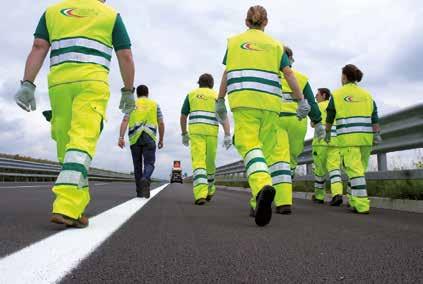


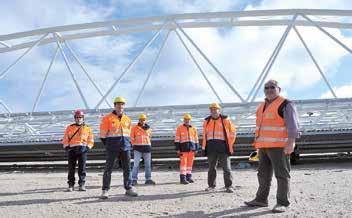

Numero Verde 800 99 60 99
InfoViaggiando - Informazioni sul traffico con operatore www.infoviaggiando.it
Percorribilità, webcam, cartografia e servizi
Seguici anche su: www.quiautovie.autovie.it Twitter: @InfoViaggiando @AutoviePress

YouTube: Autovie Venete





















Scarica la app InfoViaggiando

w w w .a u t o vie. i t
BARBACAN PRODUCE MERCATI
Design e creatività nel mercatino all’ombra dell’Arco di Riccardo —
Design and creativity market in the shade of the historic Arco di Riccardo
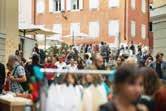
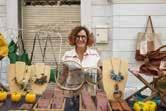
Un “design market” all’ombra dello storico Arco di Riccardo, nel cuore della città vecchia, in piazza Barbacan: lo stupore è di casa a Trieste e questo mercato di oggetti e creazioni di design ne è la conferma. Artigiani, artisti, designers, coltivatori, falegnami e creativi di ogni tipo, affermati ed emergenti, italiani, sloveni, croati e austriaci, si danno appuntamento cinque volte all’anno in questo angolo di grande fascino e suggestione per far conoscere i loro prodotti: stampe, grafiche, ceramiche, oggetti di legno, capi di abbigliamento, accessori, ma anche creme e saponi bio, oltre a semi di altissima qualità per creare un piccolo orto casalingo.
Il mercato si chiama Barbacan Produce. È nato cinque anni fa ed è cresciuto in fretta: ai prossimi appuntamenti (il 7 aprile, 9 giugno e 21 luglio) ci saranno più di 70 espositori. Orari: dalle 10.30 alle 18.30.
Info: www.barbacanproduce.com [CDL]
ENGLISH TEXT
A“design market” in the shade of the historic Arco di Riccardo, in the heart of the old town, in piazza Barbacan: Trieste can easily surprise and this design creations market is a true wonder.

Craftsmen, artists, designers, farmers, carpenters and creative people of all kinds, famous and emerging, from Italy, Slovenia, Croatia and Austria meet 5 times a year in this charming corner of Trieste to show their products: prints, pottery, woodwork, clothes, accessories but also organic soaps and creams, as well as high quality seeds to create your own vegetable garden.
The market is called Barbacan Produce. It was born 5 years ago and has grown quickly: the next dates ( 7 April, 9 June and 21 July) will feature over 70 exhibitors. Opening hours: from 10.30 a.m. to 6.30 p.m.
Info: www.barbacanproduce.com
60 TRIESTE LIFESTYLE IES N°5 — March 2019 Città da vivere
Le Fotografie di Folco Quilici
–
Photographs
by Folco Quilici
Negli spazi del museo multimediale dei Fratelli Alinari al Castello di San Giusto i lavori di Folco Quilici, grande documentarista italiano, da sempre legato al mare, suo territorio di scoperta e compagno fedele della sua vita. Le sue fotografie ci regalano l’emozione di scoprire spiagge e scogliere immacolate e approdi in cale isolate.
–Inside the rooms of the multimedia museum of the Fratelli Alinari at the Castello di San Giusto the works by Folco Quilici, great Italian documentary maker, who has always had a strong bond with the sea, he considers a place to explore and a trustful companion. His photos enable us to discover pristine beaches and cliffs and secluded havens.
info apertura: fino al 21 aprile con possibile proroga / open: until 21 April, extension is possible
orari: da martedì a domenica
10-13; 15-17 (orario invernale); 16-19 (orario estivo) / opening hours: from Tuesday to Sunday
10-13; 15-17 (winter); 16-19 (summer) ingressi: intero 5€, ridotto 4€ + ingresso al Castello / entrance: full 5€, reduced 4€ + entrance to the Castle
www.imagemuseum.eu
Le macchine di Leonardo –Leonardo’s machines
Alla Centrale Idrodinamica la mostra dedicata al grande da Vinci che, oltre a inserirsi a pieno titolo nell’ambito della valorizzazione del Porto Vecchio, intende celebrare la straordinaria figura di Leonardo nella ricorrenza del 500.mo anniversario della sua morte, accogliendo il progetto dell’Associazione Avanguardia Cafe. Sono esposte alcune “macchine leonardesche”

costruite dal professor Girolamo Covolan. Da visitare non come semplici “spettatori”, ma toccando e manovrando le riproduzioni dei macchinari, immergendosi in un passato di straordinaria attualità. –
The Hydrodynamic Power Station accommodates the exhibition dedicated to great Leonardo da Vinci, celebrating the 500th anniversary of his death, with a project by Associazione Avanguardia Cafe. Leonardo’s machines have been build by professor Girolamo Covolan. Visitors do not only look at but also touch and manoeuvre the machine models, delving into a past that is extraordinarily present.
info apertura: fino al 5 maggio / open: until 5 May orari: da giovedì a domenica e festivi 10-17 / opening hours: form Thursday to Sunday and public holidays 10-17 ingressi: intero 4€, ridotto 3€, gratuito fino ai 19 anni / entrance: full 4€, reduced 3€, free up to 19 years old www.triestecultura.it
Biennale Internazionale DonnaInternational Biennale Donna
Al Magazzino 26 nel Porto Vecchio di Trieste la seconda edizione dell’esposizione che vede protagonista l’arte femminile di centoquaranta artiste provenienti dall’Australia, dalla Cina, dall’India, dall’Africa, dalle Americhe e, naturalmente, dall’Europa. Gli spazi del Magazzino 26 accolgono la creatività dei giovani studenti del Collegio del Mondo Unito dell’Adriatico, che rappresentano ben dodici nazioni.
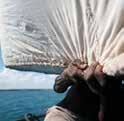
Depot 26 in the Old Port of Trieste plays host to the second edition of the female art exhibition featuring 140 women artists coming from Australia, China, India, Africa, the Americas, and Europe. The spaces inside Depot 26 accommodate the creativity of the young students of the United World College of the Adriatic, from 12 nations.
info apertura: fino al 26 maggio / open: until 26 May orari: venerdì, sabato, domenica e festivi 10-19 / opening hours: Friday, Saturday, Sunday and public holidays 10-19 ingressi: 3€, gratuito fino ai 19 anni / entrance: 3€, free up to 19 years old
www.triestecultura.it


–
61 TRIESTE LIFESTYLE IES N°5 — March 2019 Live the city
MOSTRE
Deposito a vista
La collezione del Civico Museo del Mare dedicata al patrimonio del Lloyd al Magazzino 26 del Porto Vecchio per un interessante percorso destinato a far conoscere la ricchezza qualitativa e quantitativa del fondo, punto di partenza per ricerche e studi. Circondati da una varietà di colori, tra cui il nero, il rosso e il bianco, tinte legate alle navi, vi addentrerete nel deposito a vista tra passaggi marcati, resi leggeri dal movimento di alcuni particolari come l’oscillazione dei pannelli con le onde o il gonfiarsi di alcuni veli sotto la spinta di piccoli movimenti d’aria.

The collection of the Civico Museo del Mare [Museum of the Sea] dedicated to the Lloyd shipping company heritage, at Depot 26 in the Old Port features an interesting itinerary through this extraordinary rich ship collection, starting point for research and studies. Surrounded by a variety of colours, typical of ships like black, red and white, you will walk through swinging waves and swollen sails.
info
orari: da giovedì a domenica e festivi 10–17 / opening hours: from Thursday to Sunday and public holidays 10–17 ingresso libero / free entrance
www.triestecultura.it
Magazzino delle Idee
Nello spazio espositivo di corso Cavour, a due passi dalla stazione ferroviaria di Trieste, situato sulla testata sud-est del Punto Franco Vecchio del Porto di Trieste, dal 15 al 31 marzo la mostra ‘040_ Reloaded’ negli spazi di questo edificio protetto dalle Belle Arti per il suo valore storico e architettonico. La mostra espone immagini e progetti con le ipotesi di recupero edilizio dei magazzini del Porto Vecchio di Trieste. Dal 12 aprile una nuova mostra fotografica.
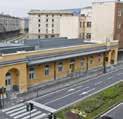
The listed building, protected by the Belle Arti for its historical and architectural value, is located in Corso Cavour, near Trieste Railway Station, on the south-east end of the Punto Franco Vecchio of the Port of Trieste. From 15 to 31 March it plays host to the exhibition ‘040_ Reloaded’, displaying images, redevelopment and restoration projects of the warehouses in the Old Port of Trieste. From 12 April a new photography display will be hosted.
info
info sul sito internet del polo culturale / info available on the website of the cultural hub.
www.magazzinodelleidee.it
Andy Warhol a Portopiccolo
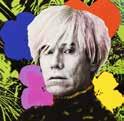
Da Marilyn Monroe alla serie completa delle Campbell’s Soup: l’arte sbarca ancora una volta a Portopiccolo con la mostra “Andy Warhol: profano come sacro”, 60 copie del maestro americano che, nel borgo di mare alle porte di Trieste, racconteranno le sue vicende artistiche e personali. I visitatori potranno scoprire i mille volti di Andy Warhol e ammirare i capolavori che hanno fatto la storia della Pop Art americana.
From Marilyn Monroe to the complete Campbell’s Soup series: Art is back at Portopiccolo with the exhibition “Andy Warhol: profane as sacred”, 60 copies by the American artist that tell us about his personal and professional experience in a beautiful location by the sea near Trieste. At the exhibition Loft visitors will be able to discover Andy Warhol’s thousand faces and admire the masterpieces that have made American Pop Art history.
info
apertura: dal 13 aprile al 22 settembre / open: from 13 April to 22 September
orari: giorni feriali 17–20; sabato e domenica, pre-festivi e festivi 10–13 e 16–20; martedì chiusura / opening hours: weekdays 17–20, Saturday, Sunday, Public holiday and pre-holidays 10–13 and 16–20; Tuesday closed.
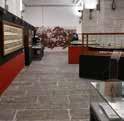
–
–
–
www.portopiccolosistiana.it MOSTRE 62 TRIESTE LIFESTYLE IES N°5 — March 2019 Città da vivere
CAFFÈ STORICO
RISTORANTE
Piatti della tradizione e sapori innovativi immersi nell’ambiente ottocentesco vivendo la storia di Trieste

CAFFÈ TOMMASEO - Piazza Tommaseo, 4/c - Trieste +39 040 362666 info@caffetommaseo.it
Un milione di mattoncini per realizzare città moderne e monumenti antichi, paesaggi medievali e angoli dell’Antica Roma, per decine e decine di metri quadrati: è “I Love Lego” la mostra allestita nel Salone degli Incanti, dedicata ai mattoncini con i quali, ogni anno, in tutto il mondo, giocano oltre cento milioni di persone, grandi e bambini.
Miniature di città, foreste, galeoni, pirati e soldati sono stati costruiti nei più minuti dettagli. E a conferma che non c’è nulla di più serio del gioco, per farlo sono scesi in campo architetti, ingegneri, informatici e finanche veri e propri artisti che hanno realizzato le loro opere usando proprio i mattoncini della Lego. Alcune delle “costruzioni” sono assolutamente uniche. Come il castello medievale costruito mettendo insieme oltre
“Grandi” miniature crescono: un milione di mattoncini per ricostruire la miniera lunare e l’Antica Roma, la foresta dei pirati e la città ideale.
—
64 TRIESTE LIFESTYLE IES N°5 — March 2019 Città da vivere
“Great” miniatures grow: one million building blocks to recreate a lunar mine and Ancient Rome, a pirates’ forest alcove and the ideal city.
250.000 mattoncini, o l’Antica Roma con i suoi soldati e i Fori Imperiali, o l’insediamento minerario lunare o l’incredibile città ideale, realizzata con 250.000 pezzi di Lego, usando finanche software Cad. Per non parlare dello Stadio Rocco e del tram di Opicina, due autentici simboli di Trieste.
Magia, sogni e suggestioni del “mondo in miniatura” firmato Lego sono a Trieste per iniziativa del Comune, dell’Associazione Culturale Arthemisia, di Genertel e di Generali Valore Cultura, il programma con il quale Generali Italia vuole rendere l’arte e la cultura accessibili a un pubblico sempre più vasto.
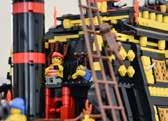

One million building blocks to recreate modern cities and ancient monuments, medieval landscapes and corners of Ancient Rome, covering dozens of square metres: it is “I Love Lego”, a display set up in the city gallery Salone degli Incanti, entirely dedicated to Lego building blocks, the world-famous miniature bricks entertaining more than one hundred users, children and adults alike, every year.
Miniature cities, forests, galleons, pirates, and soldiers, perfect in every detail. Nothing is more serious than a child’s game, which is why these works of Lego art were made by architects, en gineers, computer technicians, and fullfledged artists.

Some “buildings” are truly unique: witness the medieval castle made of 250,000 building blocks, or the land scape of Ancient Rome, with its soldiers and the Imperial Fora, or the lunar mine settlement, or even the incredible ide al city, built with 250,000 blocks and the help of a CAD [Computer-Aided Drafting] software. Trieste, the host, is honoured with reproductions of the Nereo Rocco stadium and the Opicina tram car, true symbols of the city. Magic, dreams, and suggestions from the “miniature world” of Lego, gathered in Trieste by the cooperation of the city municipality, the Arthemisia cultural as sociation, Genertel, and Generali Valore Cultura Generali Italia’s programme for the promotion of art and culture.
Nothing is more serious than a child’s game, which is why these works of Lego art were made by architects, engineers, computer technicians, and full-fledged artists.

 ENGLISH TEXT
ENGLISH TEXT
A conferma che non c’è nulla di più serio del gioco, sono scesi in campo architetti, ingegneri, informatici e finanche veri e propri artisti.
—
Daniele Clementucci “bricks”
65 TRIESTE LIFESTYLE IES N°5 — March 2019 Live the city
Luigi Folliero “yellow head”
BACCALÀ

66 TRIESTE LIFESTYLE IES N°5 — March 2019 Città da gustare
ATrieste tra stoccafisso e baccalà ci si confonde. Il primo –da “stocvish”, letteralmente pesce bastone–viene privato della testa, diviso in due e seccato all’aria fredda su delle rastrelliere, diventando appunto duro come un bastone. Il baccalà invece va sotto sale, lasciato all’aria solo in alcuni casi.
Comunque, di merluzzo essiccato si tratta, compagno di viaggio ideale di moltissime culture perché dura a lungo, è proteico e si trasporta bene. Originario dei mari del Nord, generazioni di viaggiatori e navigatori scandinavi, genovesi, veneziani, spagnoli e portoghesi l’hanno consumato avidamente ed esportato nel mondo.
Pare siano stati spagnoli e portoghesi a introdurlo nel menù triestino, e con successo se uno scrittore come Seume sostiene, all’inizio del 1800, nel suo “L’Italia a Piedi”, che anche a teatro la platea, ovunque si voltasse, “puzzava orribilmente di stoccafisso”.
Gli over “anta” triestini ricordano il negozio di alimentari Kobal in piazza Garibaldi, oggi celebrato dal musicista Lorenzo Fragiacomo (incontratelo nelle vesti di “barista cantante” al Miti Cafè di Via Torrebianca) nel suo omonimo album.
Kobal era un simbolo della Trieste anni Settanta con la scritta “Vero Ragno” sulle tende delle vetrine, zeppe di stoccafissi il cui odore si spargeva in tutta la piazza. Perché Ragno? Perchè Ragnar è il nome di un eccellente produttore delle isole Loften norvegesi, sinonimo di qualità: merluzzi più grandi, carne più bianca e gustosa.
In bianco, alla marinara, in rosso, alla triestina... tante le ricette per apprezzarlo ma a Trieste il re del baccalà è quello mantecato, spalmato su un crostino di pane.
Per una vera esperienza da “insider” dovete fare tappa in un Buffet, paradiso dello snack di metà mattina.
Il migliore? Dipende dai gusti ma provatelo al Buffet Clai, di Via Foscolo. Il padre dell’odierno proprietario lo
mantecava a mano ogni giorno, e sua madre reggeva il pentolone. Oggi si usa la planetaria a giri molto bassi per replicare quella manualità e mantenere la fibrosità tipica dello stoccafisso ragno, ammollato per almeno 24 ore e bollito per altre due. Si aggiunge solo olio extravergine di oliva, un pò d’acqua di cottura, sale e pepe per non coprire la qualità del pesce.
A poca distanza, in Via Carducci, c’è il Buffet L’Approdo, altra destinazione eccellente. La manteca è sempre in planetaria ma a giri più alti per renderlo più cremoso. Oltre a olio extra vergine d’oliva, sale e pepe, qui si aggiunge un aglio rosolato in padella. Attenzione però, lo servono solo il venerdì, giornata dedicata al pesce.
Diffidate da chi aggiunge patate, panna o latte, mascherano il gusto di uno stoccafisso non di qualità e un colore meno chiaro dovuto all’inclusione di pelle e altre parti scure della carne del pesce. Oltre a garantire più quantità.
Volete prepararlo a casa? A pagina 68 la ricetta, ma armatevi di grande pazienza, soprattutto olfattiva!
ENGLISH TEXT
In Trieste the words stockfish and baccalà are often confused. The first –derives from “stocvish”, literally stick fish– headless and divided in two, the codfish is air-dried on racks and becomes as hard as a wooden stick. The baccalà instead is salted and in some cases air-dried.
Anyway, we’re talking about dried cod, the ideal travel companion in many cultures because it is long-lasting, it contains proteins and it travels well. Originating in the North seas, generations of voyagers and sailors from Scandinavia, Genoa, Venice, Spain and Portugal, eagerly ate it and exported it all over the world.
di / by
Alice Fabi
Bianco, rosso e triestino: in città il “Vero Ragno”
è mantecato —
67 TRIESTE LIFESTYLE IES N°5 — March 2019 Taste the city
White, red and triestino: the best codfish in town is creamed
Apparently, Spanish and Portuguese travellers successfully introduced it in the Triestine cuisine and Johann Gottfied Seume wrote about it at the beginning of 1800, in his book “Spazierengang nach Syracuse”, a complete journey through Italy, in which he writes about the “terrible stock fish smell” people had even at the theatre.
Triestini over-40 remember the Kobal food shop in piazza Garibaldi, today celebrated by musician Lorenzo Fragiacomo (you can meet him as “singing barista” at the Miti Cafè in Via Torrebianca) in his album. Kobal was a symbol of Trieste in the 70s with the words “Vero Ragno” on the shop windows. Inside it was full of stockfish and the smell spread all over the square. Why Ragno? Because Ragnar is the name of an excellent producer from Norway’s Loften islands, and synonym for quality: large cod with tasty white meat.
With or without tomato sauce, marinara style, Triestina style... there are many ways you can enjoy baccalà but in Trieste the most popular is creamed codfish, spread on toasted bread.
For a true local experience, you should stop at a Buffet Bar, for a mid-morning heavenly snack. The best place? Depends on your personal taste
but you should try it at the Buffet Clai, in Via Foscolo. The father of the current owner used to hand-cream it every day, whilst his mother held the pot. Today he uses a mixer at very low speed to replicate that movement and maintain the typical texture of the Ragno stockfish, soaked for at least 24 hours and boiled for another two hours. You only add extra virgin olive oil, a bit of cooking water, salt and pepper, so as not to hide the quality of the fish. Not far away, in Via Carducci, there is the Buffet L’Approdo, another excellent place. The cod is creamed with a mixer but at a higher speed to make it creamier. Besides extra virgin olive oil, salt and pepper, here they add a stir-fried garlic clove. However, they only serve it on Friday, the day dedicated to fish.
Be wary of those who add potatoes, cream or milk, these ingredients are used to disguise the taste of a low quality stockfish, and brighten its darker colour due to the presence of skin and other parts of the fish. In this way you can prepare a greater amount too. Do you want to prepare it at home? Here’s the recipe but arm yourself with patience, and prepare yourself for the strong fishy odour that will follow you for days!
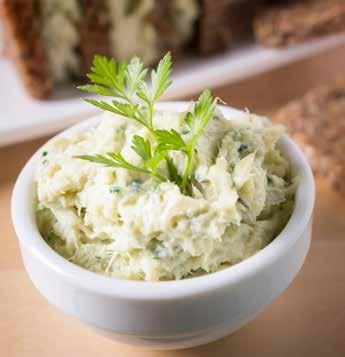
La ricetta
300gr di stoccafisso
Olio Extra Vergine di Oliva (delicato)
Sale, Pepe
Lasciate a mollo lo stoccafisso per almeno 24 ore; pulite, spinate e tagliate in tranci. Bollite per circa due ore. Mantecate con una planetaria –per i più coraggiosi a mano–aggiungendo poca acqua di cottura e raggiungete la consistenza desiderata versando l’olio a filo. Condite con sale e pepe a piacere. Questa è la ricetta più tradizionale, si possono aggiungere aglio (crudo o rosolato) e prezzemolo.
The recipe
300gr stockfish
Extra Virgin Olive Oil (light) Salt, Pepper
Leave stockfish to soak in cold water for at least 24 hours; rinse it, take the bones out and cut into pieces. Boil for about 2 hours. Cream the fish with a mixer –if you are brave enough you can try by hand–adding a bit of cooking water and pouring little amounts of olive oil at a time until you reach the desired texture. Season with salt and pepper, to your taste. This is the most traditional recipe, but you can also add garlic (raw or fried) and parsley.
68 TRIESTE LIFESTYLE IES N°5 — March 2019 Città da gustare
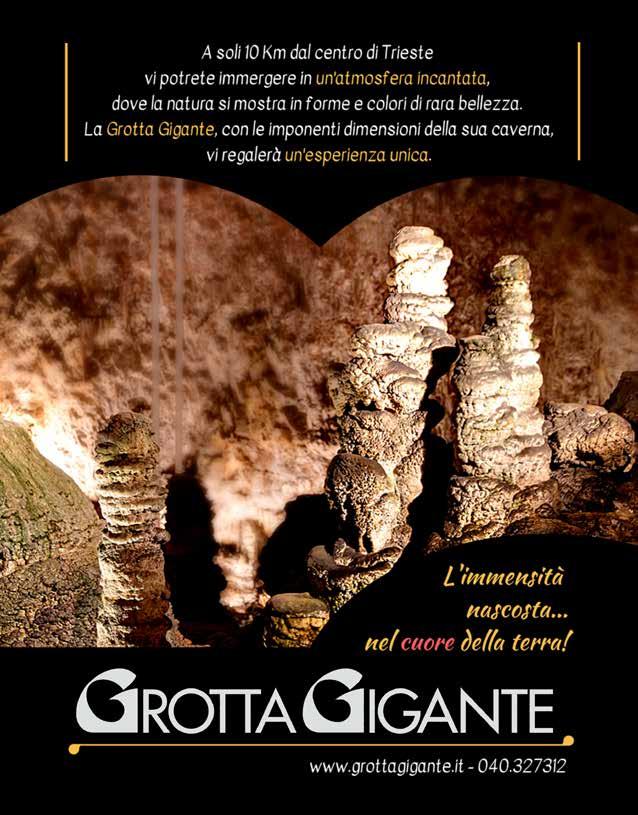
THE BEST JOTA È
forse il piatto simbolo della gastronomia triestina e a questa particolare minestra la città ha dedicato una sorta di festival culinario denominato Jotamata, con una qualificata giuria chiamata a eleggere lo chef capace di cucinare la miglior jota della città. Ecco chi ha vinto... 195 centimetri di altezza, 35 anni, barba lunga, un passato da arbitro internazionale di basket, una laurea in biologia marina, coltivatore di 10 ettari di campagna oltre confine a Corte d’Isola e soprattutto una grande passione per la cucina. Questo in sintesi è Matija Antolovic, talentuoso chef dell’Antico Caffè San Marco che ha vinto la prima edizione di Jotamata.
Vi chiederete allora come fa un biologo marino a vincere un contest a base
di crauti, fagioli e maiale? La risposta è semplice: seguendo la tradizione, ma soprattutto il rispetto degli ingredienti, che siano di origine vegetale o animale. Ecco la filosofia che contraddistingue la cucina di questo chef: qualità della materia, stagionalità dei prodotti e impatto minimo sull’ecosistema quando si prepara da mangiare, rispettando natura e ambiente. Da qui ecco nascere una cucina sincera ed onesta. “Dal primo momento in cui mi sono inoltrato nel mondo della cucina –racconta Matija–mi sono accorto sempre di più dell’impossibilità di evitare gli errori. Ma solo nell’errore è racchiusa l’occasione del sapere. Spero perciò di continuare a sbagliare”. Info: Antico Caffè San Marco 040-0641724 .

70 TRIESTE LIFESTYLE IES N°5 — March 2019 Città da gustare
IN CITTÀ
It is probably the most symbolic dish of Trieste’s cuisine – and now it has its own dedicated festival: the Jotamata, during which a qualified jury selects the chef who made the best jota [local soup] in town. And the winner is…

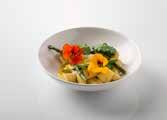

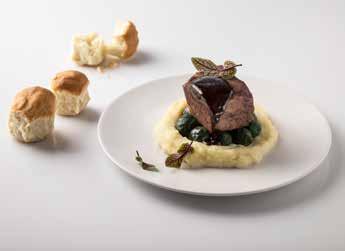
Long beard, 195 cm tall, 35 years old, former international basketball referee, with a degree in marine biology, ten hectars of cultivated land in Korte (Slovenia), and, most importantly, a true passion for cooking: this is Matija Antolovic, talented chef of the café
Antico Caffè San Marco, winner of the first edition of Jotamata.
You may wonder how a marine biologist can win a contest based on sauerkraut, beans, and pork meat. The answer is simple: by respecting tradition, and most importantly ingredients, of both plant- and animal origin. This is the main trait of his cuisine: high-quality material, seasonal products, and low impact on the ecosystem, in the respect of nature and the environment. The result is authentic, genuine cuisine.
“From the moment I approached the catering world –Matija explains– I realised that avoiding mistakes was impossible. And yet, mistakes are unique opportunities to acquire knowledge. So I hope I will keep making mistakes…”.
Info: Antico Caffè San Marco 0400641724.
Un biologo marino vince un contest a base di crauti, fagioli e maiale
ENGLISH TEXT
— How a marine biologist can win a contest based on sauerkraut, beans, and pork meat
71 TRIESTE LIFESTYLE IES N°5 — March 2019 Taste the city
Dalla jota alla fantasia: i piatti dello chef Matija Antolovic
CASA PEPE
Napoli in tavola: pizza, ma non solo — Naples at table: pizza, but not only
Le prime pizze cotte nei forni a legna sbarcarono a Trieste all’inizio degli anni ’60. E fu subito amore a prima vista, anzi, a primo morso. In quasi sessant’anni è quasi riduttivo parlare di crescita esponenziale per un piatto non a caso divenuto patrimonio dell’UNESCO. Sta di fatto, però, che l’amore per la pizza in quest’angolo di nord est è semplicemente contagioso, quasi anomalo, se contiamo il numero di pizzerie rispetto agli abitanti. Negli ultimi anni, poi, all’amore per pomodoro e mozzarella si è aggiunto quello per la cucina napoletana tout court. E tra i primi ad intuire questa nuova passione gastronomica anche a nord, è stato questo locale, Casa Pepe. Leggermente decentrato rispetto ai luoghi della “movida enogastronomica”, ma pur sempre in centro città, proprio a fianco dell’imponente struttura del Tribunale di Trieste, quella che fino a qualche anno fa tutti ricordavano semplicemente come appunto la pizzeria “al tribunale”, ha saputo ritagliarsi un suo ben definito spazio e soprattutto un’affezionata clientela.
Il segreto? “Far sentire il cliente a casa…” rispondono all’unisono Pietro, Adi e Susanna, quest’ultima indimenticabile e indimenticata (vedendola…
capirete perché!) miss Italia, una trentina d’anni fa. La missione di Casa Pepe oggi è quella di seguire i piatti della tradizione, riproponendo le ricette delle nostre mamme (in qualche caso delle nostre nonne), come le ormai quasi introvabili zuppe di legumi piuttosto che i sedanini con il baccalà.
Mentre un capitolo a parte merita la regina del menù, una pizza napoletana che segue il disciplinare STG (specialità tradizionale garantita), avendo cura delle materie prime e del metodo; quindi leggerezza, idratazione e giusta lievitazione, variando con impasti classici e integrali e soprattutto con prodotti DOP, quali il pomodoro vesuviano del piennolo, il pomodorino giallo del Cilento, la cipolla di Tropea, le olive taggiasche, la mozzarella di bufala campana, il guanciale e il prosciutto di Amatrice.
Ma se proprio vorrete andare oltre la specialità della casa, per rifiugiarvi nelle carni di qualità cotte anche alla brace, ricordatevi che troverete le “piemontesi” della macelleria Oberto, cento per cento made in Italy. Occorre altro? Forse solo una simpatica e non banale aggiunta: in estate potrete cenare al fresco di un giardino che non è proprio facile trovare in centro città.
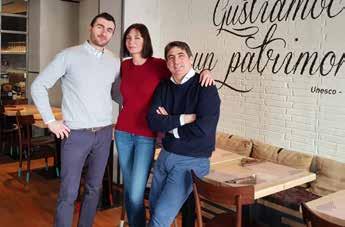
FOOD 72 TRIESTE LIFESTYLE IES N°5 — March 2019 Città da gustare
The first pizzas cooked in wood-fired ovens arrived in Trieste at the beginning of the ’60s, and it was immediately love at first sight, or rather, at first bite. After almost sixty years, it is rather reductive to speak about an exponential growth for a dish that has not by chance become UNESCO world heritage. It is a fact, that the love for pizza in this north easternmost corner of Italy is simply contagious, almost unexpected, if we count the number of pizza places compared to the density of inhabitants. Moreover, in recent years, the love for tomato and mozzarella has expanded to the Neapolitan cuisine tout court. And Casa Pepe has been among the first who intuitively grasped this new food passion in the north. The restaurant is slightly decentralized compared to the location of the “food&wine nightlife”, but nevertheless in the city centre, just opposite the imposing Court of Trieste, once simply known as the pizzeria “al tribunale”, has been able to carve out a well defined space and above all a large number of loyal customers.
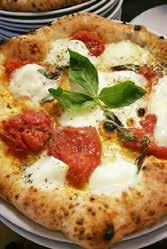
The secret? “Make customers feel at home…” said Pietro, Adi and Susanna, this latter is the unforgettable (if you see her… you’ll understand why!) Miss Italia, who won the title about thirty years ago.
Casa Pepe’s mission today is that of following tradition, re-proposing our moms’ recipes (and in some cases our… grandmas’), such as the legume soups or “sedanini pasta with baccalà” that you won’t find anywhere else.
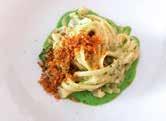
The queen of the menu deserves a separate chapter: a Neapolitan pizza that follows S.T.G. guidelines, taking care of raw materials used and preparation methods, which ensure lightness, moisture and correct rising process, using classic or wholemeal dough with AOP products, such as the Pomodorino del Piennolo del Vesuvio , the yellow Pomodorino del Cilento, Tropea onions,

Taggiasche olives, Mozzarella di Bufala Campana, guanciale and prosciutto from Amatrice.
But if you really want to go beyond the specialties of this restaurant, you can indulge yourself into charcoal grilled quality meat: you can find Piemontese cattle beef from Oberto butcher shop, 100% made in Italy. Anything else? Maybe just one more pleasant feature: in the summer you can dine in the fresh garden, a green haven that is not easy to find in the city centre.

ENGLISH TEXT
segreto? Far sentire
cliente a casa. — The secret?
customers feel at home. 73 TRIESTE LIFESTYLE IES N°5 — March 2019 Taste the city
Il
il
Make
PINZA & COTTO P
robabilmente non lo troverete nei menù dei ristoranti, ma questo è un piatto che a Trieste (soprattutto durante il periodo pasquale) va provato. L’abbinamento può stupire, ma fino a un certo punto: pinza e prosciutto cotto, possibilmente caldo.
Non poteva mancare, uno dei più antichi dolci cittadini in abbinamento con uno dei simboli gastronomici della città, il prosciutto cotto in crosta. Come detto, farete fatica a trovarlo come proposta nei locali cittadini (il solo “vecchio” Suban, quasi per scherzo, ve lo servirà come entree non richiesta del pranzo pasquale!), ma con un semplice “fai da te” potrete assaggiarlo anche fuori pasto. Sarà sufficiente tagliare delle sottili fette di pinza e adagiarci sopra un’altrettanto sottile fetta di prosciutto: l’abbinamento dolce-salato risulterà gradevolissimo. Le brioche salate che spopolano oggi dì le nostre nonne e bisnonne le avevano inventate tanti, ma tanti anni fa.
It may not feature on the menus of renowned restaurants, and yet it must be tried at least once when in Trieste (especially around Easter): Pinza&Cotto, namely pinza [traditional dessert flan] and baked ham, possibly served hot – it might seem a hazardous match, although only to a certain extent. After all, it was only to be expected that this traditional dessert would eventually meet one of the city’s gastronomic symbols, namely baked ham. Again, you will not find it in local restaurants (except maybe at “old” Suban, where you may be mockingly served this combination as appetizer at Easter lunch), but you can still taste it as a do-it-yourself snack. You only need to cut really thin slices of pinza and gently lay your baked ham on them: this sweet and salty match will make your mouth water. It may remind you of the modern croissant sandwich, except our grandmothers had discovered it way, way before us.

ENGLISH TEXT
—
Abbinamento che può stupire, ma fino a un certo punto: pinza e prosciutto cotto, possibilmente caldo.
Pinza and baked ham, possibly served hot: it might seem a hazardous match, although only to a certain extent.
74 TRIESTE LIFESTYLE IES N°5 — March 2019 Città da gustare
La pinza prodotta dall’azienda dolciaria artigianale Pintaudi.
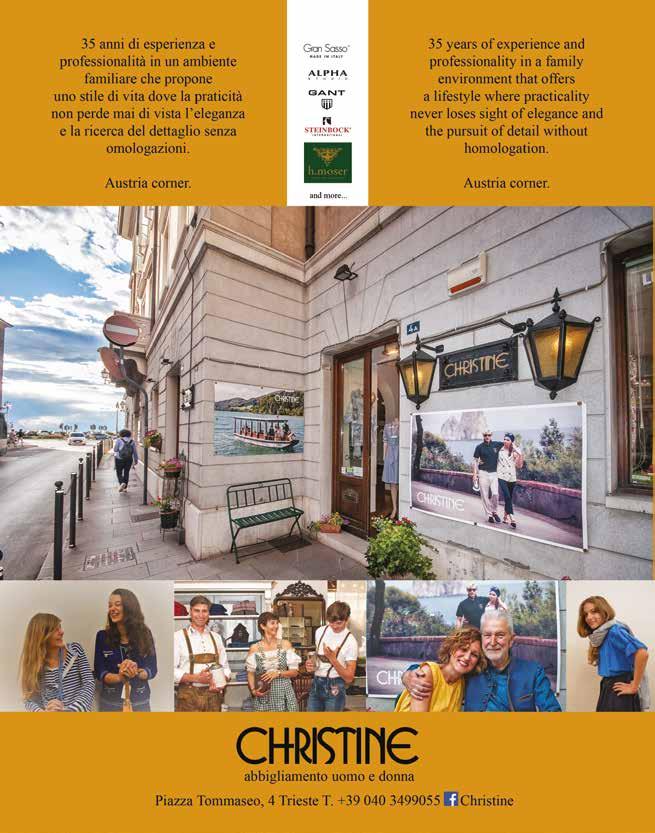
IL CAFFÈ DI TRIESTE
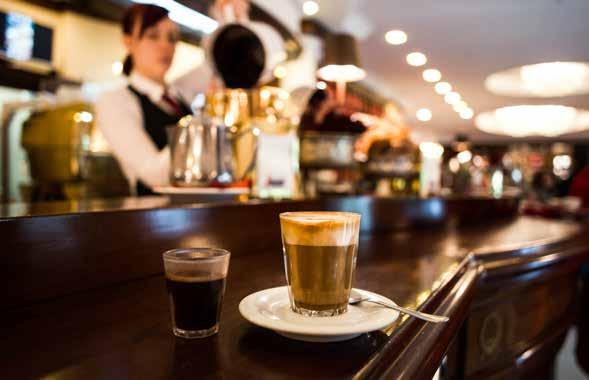
Non solo buon caffè e un’ottima cioccolata: al Caffè degli Specchi anche una straordinaria scelta nel breakfast mattutino. —
Delicacies were mentioned: at Caffè degli Specchi not only can you taste mouth-watering chocolate and delicious coffee, but you also have a vast choice of breakfast.
Si affaccia e occupa parte di quella che è la più grande piazza d’Europa aperta sul mare, una delle più belle d’Italia: dal 1839 il Caffè degli Specchi, è “il caffè di Trieste”, al di là delle classifiche e della storia di una città che per i suoi caffè è famosa nel mondo, sulla scia della tradizione viennese per questi luoghi di “culto”.
Storia secolare ma anche travagliata quella di questo locale: basti pensare che alla fine del secondo conflitto mondiale i suoi vani vennero adibiti ad alloggiamento truppe, magazzini, addirittura stalle. Nel 1945, al termine della Guerra, fu requisito dalle truppe angloamericane e solo dopo il ’54 i triestini poterono lentamente ricominciare a godere del loro caffè preferito. Un luogo che rispecchia la città di Trieste, dove il caffè è sempre stato terra di conquista per una città importante dal punto di vista strategico e anche politico.
Ma è da pochi anni che il caffè di piazza Unità d’Italia è tornato ai fasti di un tempo, in coincidenza con l’acquisizione della struttura nel 2012 da parte della famiglia Faggiotto, cioccolatieri a Pordenone con la Peratoner, considerata tra le prime cinque migliori
cioccolaterie d’Italia. Un marchio destinato a uscire dagli ormai stretti confini del nordest italico.
Il segreto? La straordinaria qualità dei prodotti offerti, a cominciare ovviamente dalla cioccolata che vi viene regalata in assaggio assieme al caffè; ma anche la gentilezza di una squadra di camerieri e banconieri, con un sincero sorriso perennemente stampato in volto. E poi –aggiungiamo noi– la forza di Giuseppe Faggiotto e il supporto della moglie Anna della casa madre Peratoner, che in una città non proprio caratterizzata da un clima mite, ha avuto il coraggio di tenere sempre attivi per dodici mesi l’anno gli oltre 320 posti a sedere all’aperto, ai bordi della piazza. Anche nelle giornate più fredde, basta la copertina d’ordinanza che troverete su quei divani e poltrone per assaggiare le specialità della casa e godersi lo struscio di una città che ti sfila davanti nel suo salotto buono. Per non parlare di quelli che negli anni sono diventati clienti abituali del caffè: artisti, politici, imprenditori.
Il motto della famiglia Faggiotto “il lusso deve essere per tutti” ha fatto sì che il più grande caffè della città diventi
76 TRIESTE LIFESTYLE IES N°5 — March 2019 Città da gustare
accessibile proprio a tutti e adesso, grazie anche all’impegno dei figli Riccardo e Filippo, gli Specchi è frequentato pure da giovani e studenti universitari.
Parlavamo delle specialità: non solo buon caffè e un’ottima cioccolata, ma anche una straordinaria scelta nel breakfast mattutino: continental o american , con le più svariate declinazioni a seconda di gusti ed abitudini di una clientela sempre più internazionale. Per non parlare dello Specchi Bistrot,attivo dalle 12 alle 21, che parte da uno spuntino da consumarsi in poco tempo, per arrivare a sfiziosi piatti che mescolano la tradizione del territorio ai tesori del mare. Il tutto innaffiato col vino giusto. E da queste parti, sul tema non si scherza.
Its windows open toward the openair tables, sitting in the largest square in Europe overlooking the sea and one of the most beautiful in Italy: since 1839 Caffè degli Specchi has been The Café of Trieste, regardless of rankings and vicissitudes that made this city famous for her cafés, true to a ritual that originated from the Viennese tradition. Through the centuries this place has lived a tormented history: suffice it to mention those years when, towards the end of the Second World War, its rooms were turned into troop lodgings, warehouses, even stables. In 1945, at the end of the conflict, the place was confiscated by the Western Allies and only 1954 was the building returned to the city, so that the Triestini could slowly resume their daily routine in their favourite venue. This place and its history epitomize the very city of Trieste, with the Café as an eternal battleground, all due to the its strategic and political significance.
Only recently was Caffè degli Specchi restored to its former glory, thanks to the building’s acquisition by the Faggiotto family, master chocolatiers based in Pordenone, whose chocolate company, Peratoner, is considered one of the top five in Italy – a brand soon to be known well beyond narrow borders of the region.
Their secret? High-quality products, first and foremost chocolate, of course, which is now served as a complimentary treat together with coffee beverages; but also the kindness characterising the whole team of waiters and bartenders, who greet each customer with a bright and authentic smile

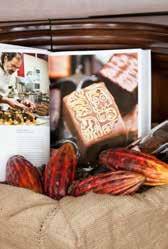
that never fades. And finally –in our own opinion– Giuseppe Faggiotto’s energy, combined with his wife Anna’s support from their headquarters at Peratoner: in a city whose winters are anything but mild, he made the brave decision of offering open-air tables all the year round, covering a surface that can seat more than 320 guests right on the square. Even on the chilliest of winter days you can nestle in one of the café’s comfortable armchairs or sofas, cosily wrapped in the mandatory blanket, and enjoy one of the many delicacies offered on the menu, while the city elite shuffles by. Some of them are regular customers here, the very crème de la crème of politics, business, and the art world.
The Faggiotto family’s slogan “affordable luxury for everyone” has opened the doors of the largest café in Trieste to anyone, including young people and University students, mainly thanks to the efforts of Riccardo and Filippo, Giuseppe’s sons.
Delicacies were mentioned: at Caffè degli Specchi not only can you taste mouth-watering chocolate and delicious coffee, but you also have a vast choice of breakfast, including continental and American breakfast, with a taste for every palate. From 12 a.m. to 9 p.m. the increasingly international patronage of the café can access the Specchi Bistrot: here you can choose from a wide selection of options, ranging from a quick snack to a lavish lunch, each portion the perfect combination of local tradition and seafood delicacies. Not to mention the impressive wine list – something that is taken quite seriously around here.

ENGLISH TEXT
77 TRIESTE LIFESTYLE IES N°5 — March 2019 Taste the city
FUORI PORTA
ENJOY COLLIO
Pic Nic Experience, Rural Dinner, Event Dinner, degustazioni, mostre, premi, dibattiti, passeggiate, laboratori del gusto, visite in vigne e cantine e un concerto con uno jazzista del calibro di Enrico Rava: scoprire il Collio è sempre un’esperienza straordinaria ma farlo dal 29 maggio al 2 giugno significa vivere sensazioni e suggestioni veramente uniche. L’occasione è Enjoy Collio Experience, un modo di immergersi in un territorio straordinario incontrando le persone che lo animano e degustando i vini che produce. “15 experience, 5 giorni, 1 solo Collio” è il filo conduttore di una lunga serie di scoperte alla quale, per iniziativa del Consorzio di Tutela dei Vini del Collio, l’Ersa e Promoturismo Fvg, partecipano decine di giornalisti, sommeliers, esperti, tecnici ma soprattutto semplici wine lovers che arrivano sulle colline goriziane da mezzo mondo, dagli Stati

Uniti al Canada, dalla Germania alla Gran Bretagna, dalla Cina al Giappone. Compresa una delegazione di 15 formatori della Wine Scholar Guild, una rete internazionale certificata con più di 10.000 aderenti e sedi in tutto il mondo. Tutti –e non solo per i cinque giorni di Enjoy Collio– sono chiamati a raccontare itinerari, viti, vini, vigne, persone e borghi. Con gli strumenti tradizionali della scrittura e della fotografia, ma anche con i nuovi mezzi della comunicazione 4.0, a cominciare dai social, dai più consolidati ai più innovativi. Per scoprire la nuova dimensione del Collio, da sempre una terra di grandissimi vini che hanno conquistato tutto il mondo e da qualche anno anche un luogo nel quale la qualità delle produzioni va di pari passo con la qualità dell’ambiente, perchè l’eccellenza non sia solo quella dei vini ma anche della natura nella quale vengono prodotti. [CDL]
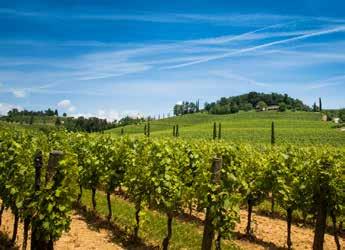
Persone, vino e territorio da vivere con 15 experience in cinque giorni —
People, wine and territory to enjoy through 15 experiences in five days
78 TRIESTE LIFESTYLE IES N°5 — March 2019 Città da gustare
Pic Nic Experience, Rural Dinner, Event Dinner, food&wine tasting, exhibitions, prizes, debates, walks, tasting workshops, visits to vineyards and wine cellars and a jazz concert with great artist Enrico Rava: discovering Collio is always an extraordinary experience but from 29 May to 2 June it is a truly enthralling and inspiring period. The event is Enjoy Collio Experience, a way to plunge into an extraordinary territory meeting the people that live there and tasting the wines they produce. “15 experiences, 5 days, 1 Collio” is the leitmotif of a long series of events organized by the Consorzio di Tutela dei Vini del Collio, Ersa and Promoturismo Fvg, where dozens of journalists, sommeliers, experts, but also wine lovers who reach the hills around Gorizia from all over the world,
from the United States to Canada, from Germany to Great Britain, from China to Japan. There will also be a delegation of 15 trainers of the Wine Scholar Guild, a certified international network with over 10,000 members and branches all over the world. Everybody –and not only during the Enjoy Collio days– is invited to talk and write about itineraries, vineyards, wines, people and villages. You can use the traditional tools of writing and photography, but also the new 4.0 communication means, starting from social media, from the most popular to the most innovative. This is how you can discover Collio’s new dimension, a land of great wines that have enchanted the whole world. A territory where recently the quality of its products has gone hand in hand with the quality of the environment because excellence should not only regard wines but also the natural environment where they are produced.

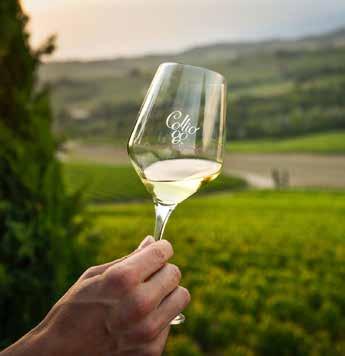
ENGLISH TEXT
Scoprire il Collio è sempre un’esperienza straordinaria ma farlo con Enjoy
Collio significa vivere sensazioni e suggestioni veramente uniche.
—
79 TRIESTE LIFESTYLE IES N°5 — March 2019 Taste the city
Discovering Collio is always an extraordinary experience but from 29 May to 2 June it is a truly enthralling and inspiring period.
MARCOPOLO
È in edicola il numero di aprile di Diari di Viaggio by Marcopolo, la rivista di viaggi e lifestyle aggiornata e completa. In questa uscita, le Speciale Pasqua e Ponti di primavera: tante idee per vacanze e weekend lunghi, da Ponza, Ischia, Favignana e la Sardegna per il primo mare, le città del momento, da Torino a Berlino, e gli agriturismi per soggiorni di relax nel verde.
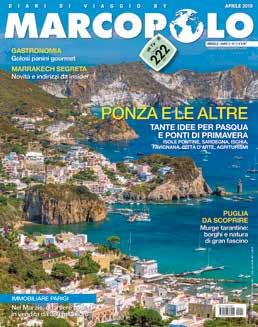
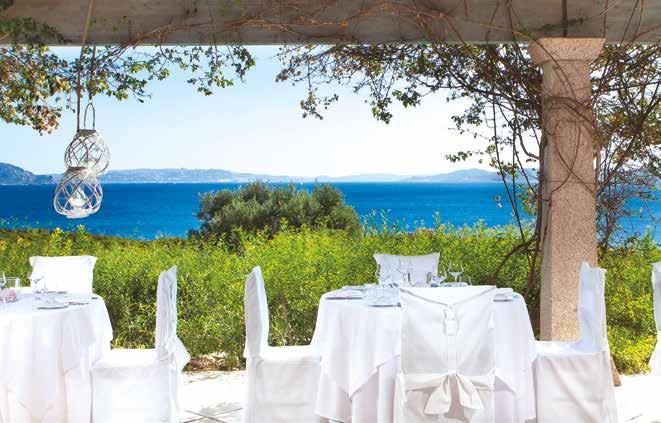
Reggio Emilia: bellezze artistiche e specialità da gustare. Puglia da scoprire: tra le gravine e i borghi della Murgia tarantina.
Marrakech: le novità, gli indirizzi top e le “dritte” da insider della capitale marocchina.
Aruba: le spiagge, la natura e i resort da sogno dell’isola felice. Gastronomia: dove trovare i panini più gustosi, in fantasiose versioni gourmand o addirittura stellate.
Centinaia di indirizzi selezionati, informazioni pratiche, cartine e tante splendide fotografie.
IN EDICOLA
La vista dal ristorante Grecale del Resort Valle Dell’Erica Thalasso & Spa in Sardegna


www.severalbroker.it





comune di trieste A Trieste la cultura è di casa Comune di Trieste @ComunediTrieste ComunediTrieste LLOYD Deposito a vista La mostra permanente al Magazzino 26 del Porto Vecchio di Trieste Amare la città attraverso la storia della sua marineria











































































































 ENGLISH TEXT
ENGLISH TEXT


























